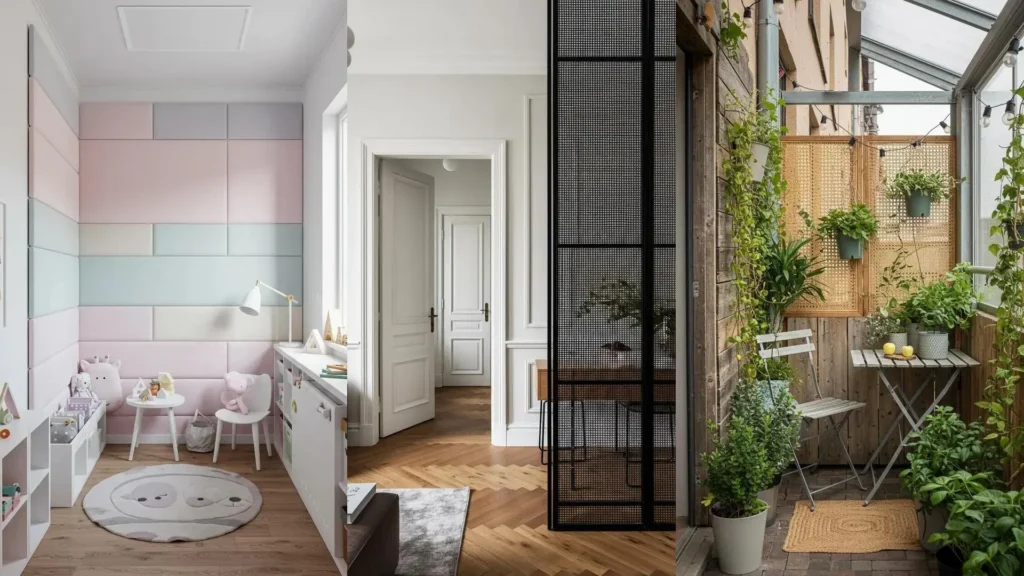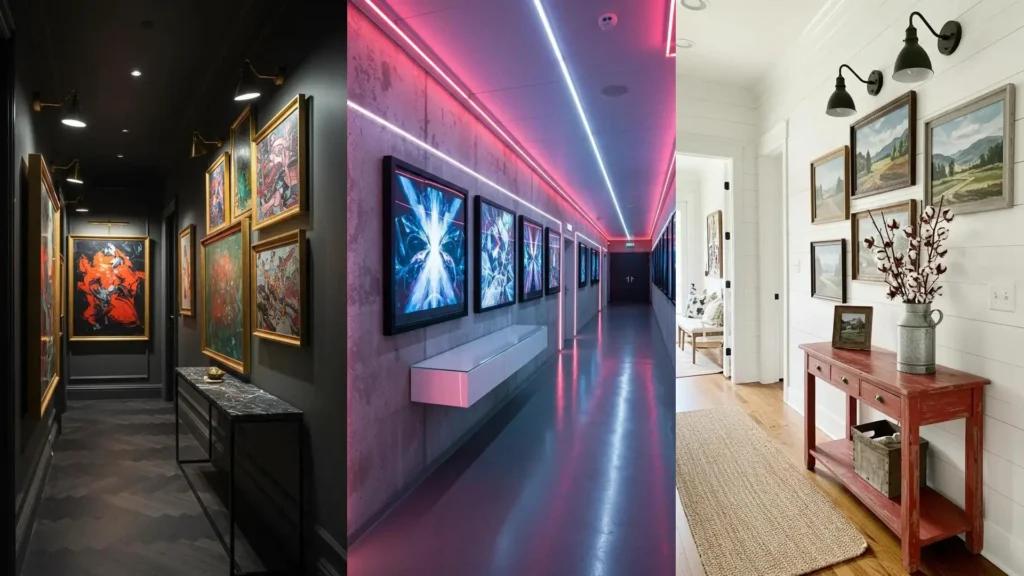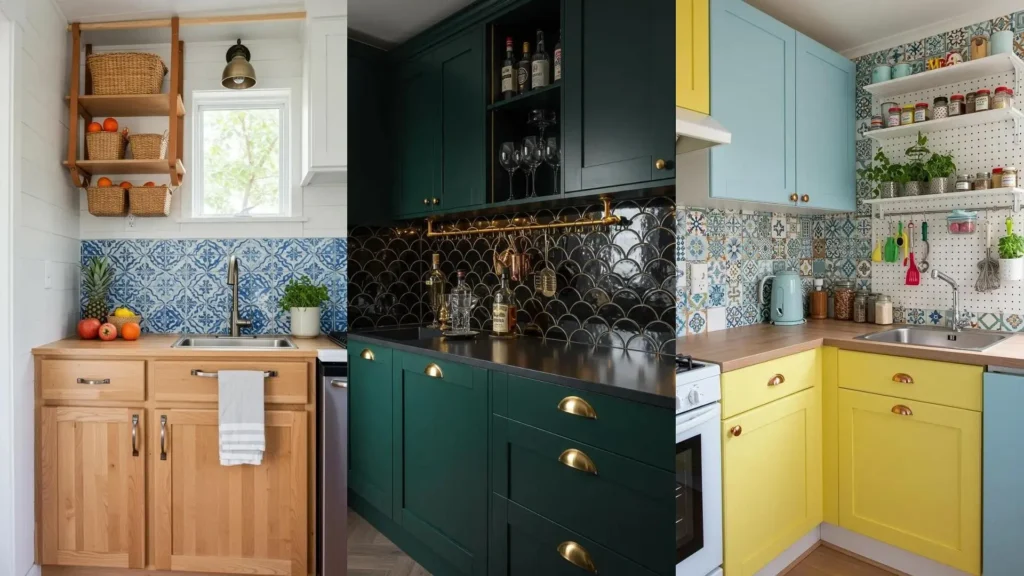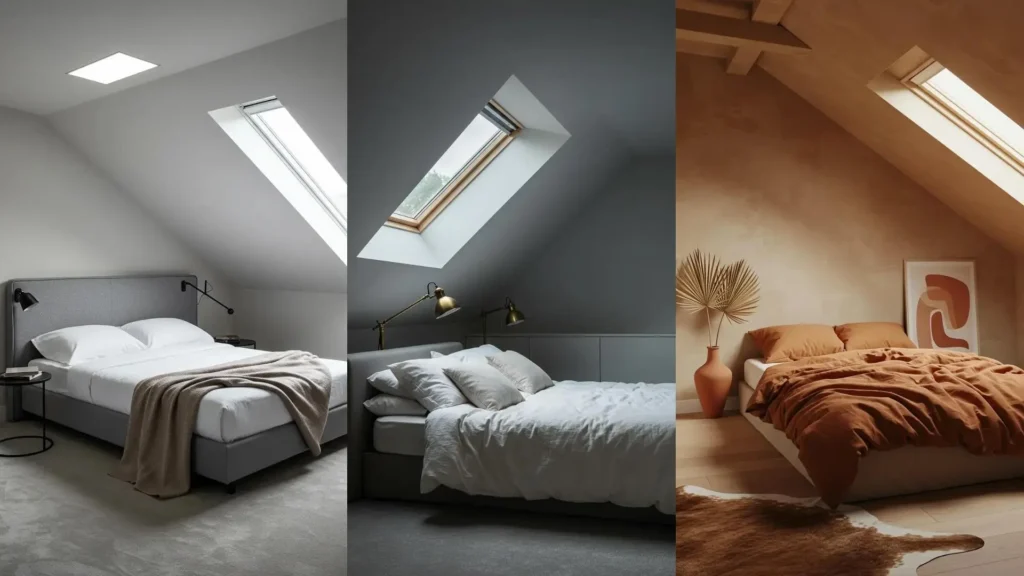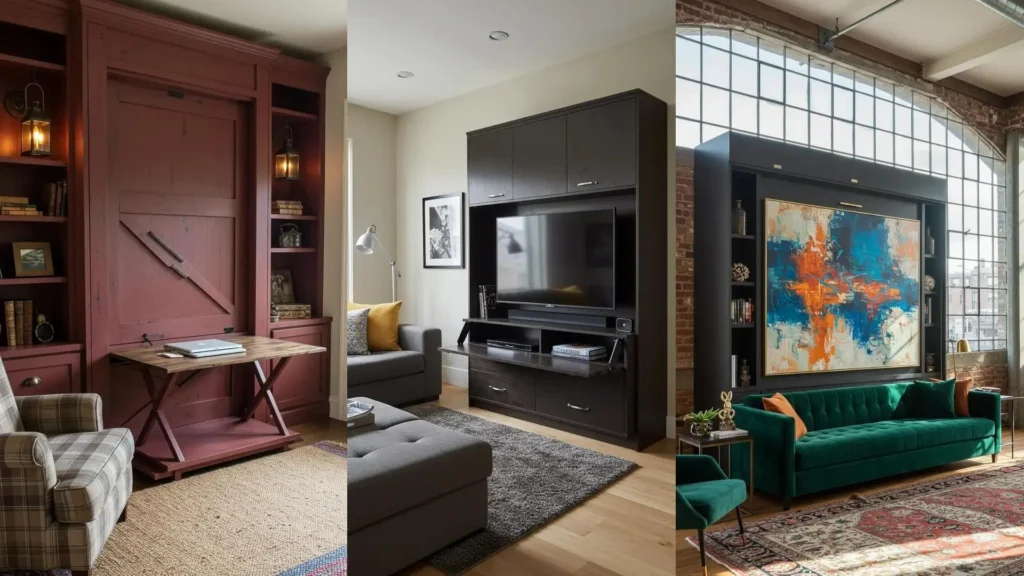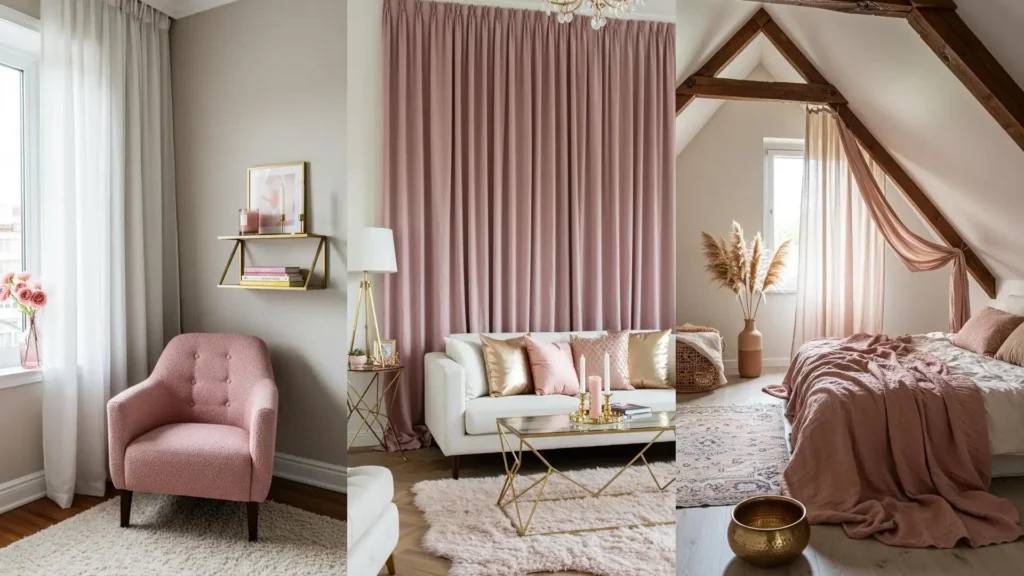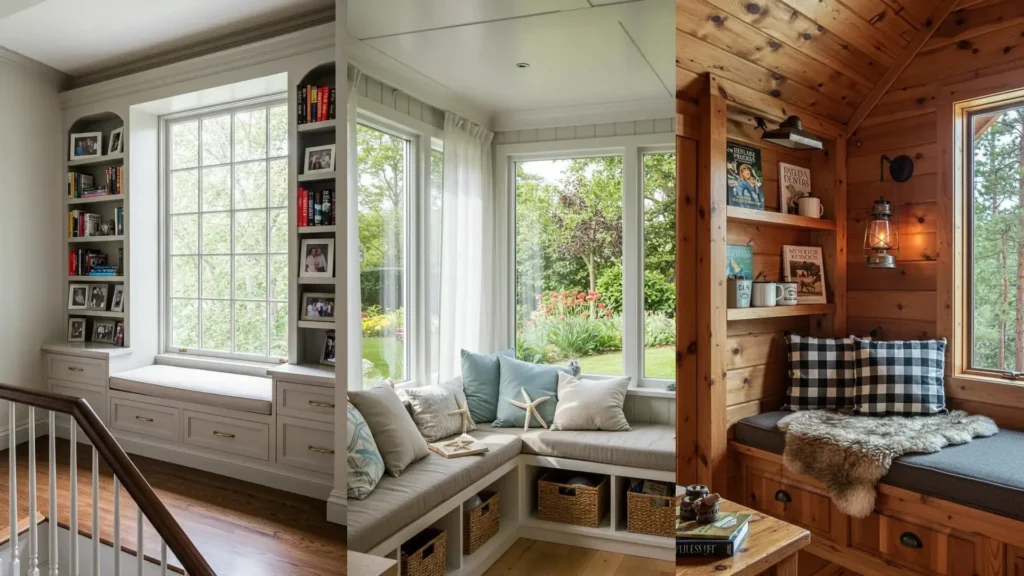When you want to transform a room, it’s often the subtle shifts in texture and dimension that make the most profound difference.
You don’t need a complete overhaul to create a space that feels more intentional, personal, and calm.
Instead, think of your walls and corners as opportunities. A simple screen can carve out a sanctuary, while a panel of wood or fabric can introduce a layer of architectural warmth that was never there before.
These are more than just decorative touches; they are tools to redefine your space, adding depth, character, and a quiet sense of order.
1. The Light-Filtering Room Divider
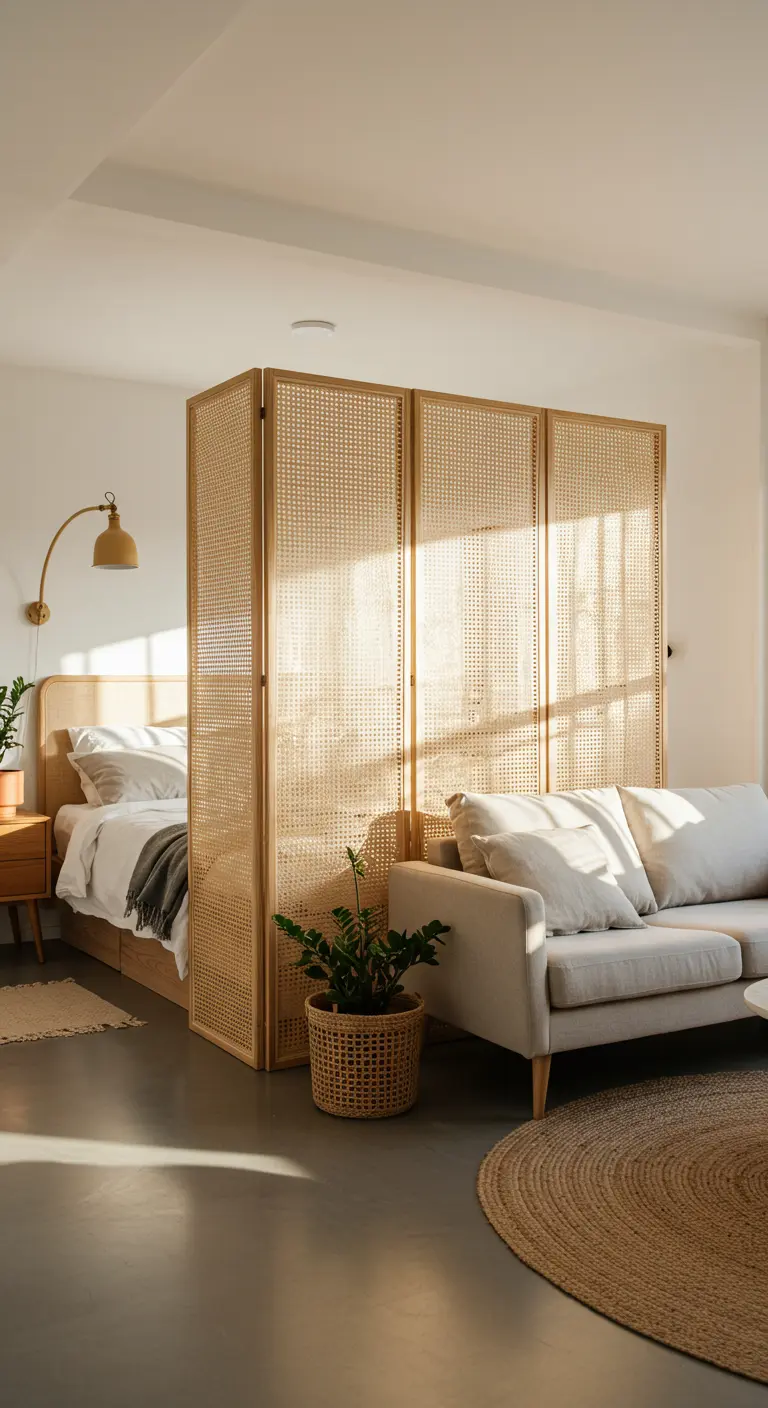
In a studio or open-plan room, use a cane screen to create a soft boundary between your sleeping and living areas.
Its woven texture adds organic warmth that can be missing from modern spaces, but because it’s semi-transparent, it defines the zone without blocking light or making the room feel smaller.
For a different effect, a solid linen-covered screen offers more privacy, while a slatted wood divider introduces a more rigid, architectural feel.
This is a particularly graceful solution for open-plan rooms where flexibility is key.
2. The Architectural Headboard with Integrated Light
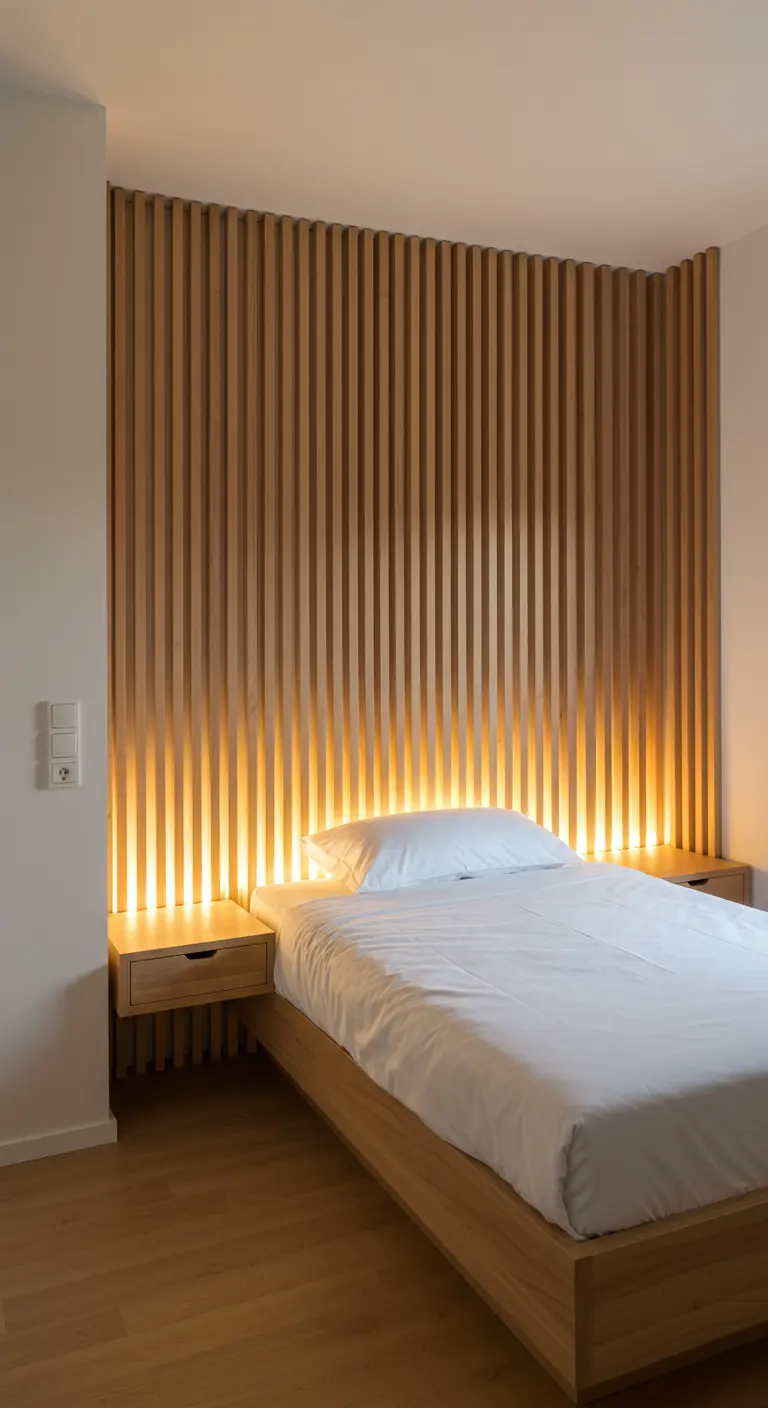
Replace a standard headboard with a floor-to-ceiling slatted wood wall to introduce a strong vertical element that makes ceilings feel higher.
Integrate LED strip lighting along the bottom edge behind the slats to cast a warm, ambient glow that doubles as a reading light.
This built-in feature eliminates the need for bulky bedside lamps, freeing up precious space on your floating nightstands.
Keep bedding simple and crisp to allow the woodwork to remain the undisputed hero feature of the room, a tactic often used in minimalist romantic bedroom concepts.
3. Acoustic Softness with Upholstered Wall Panels
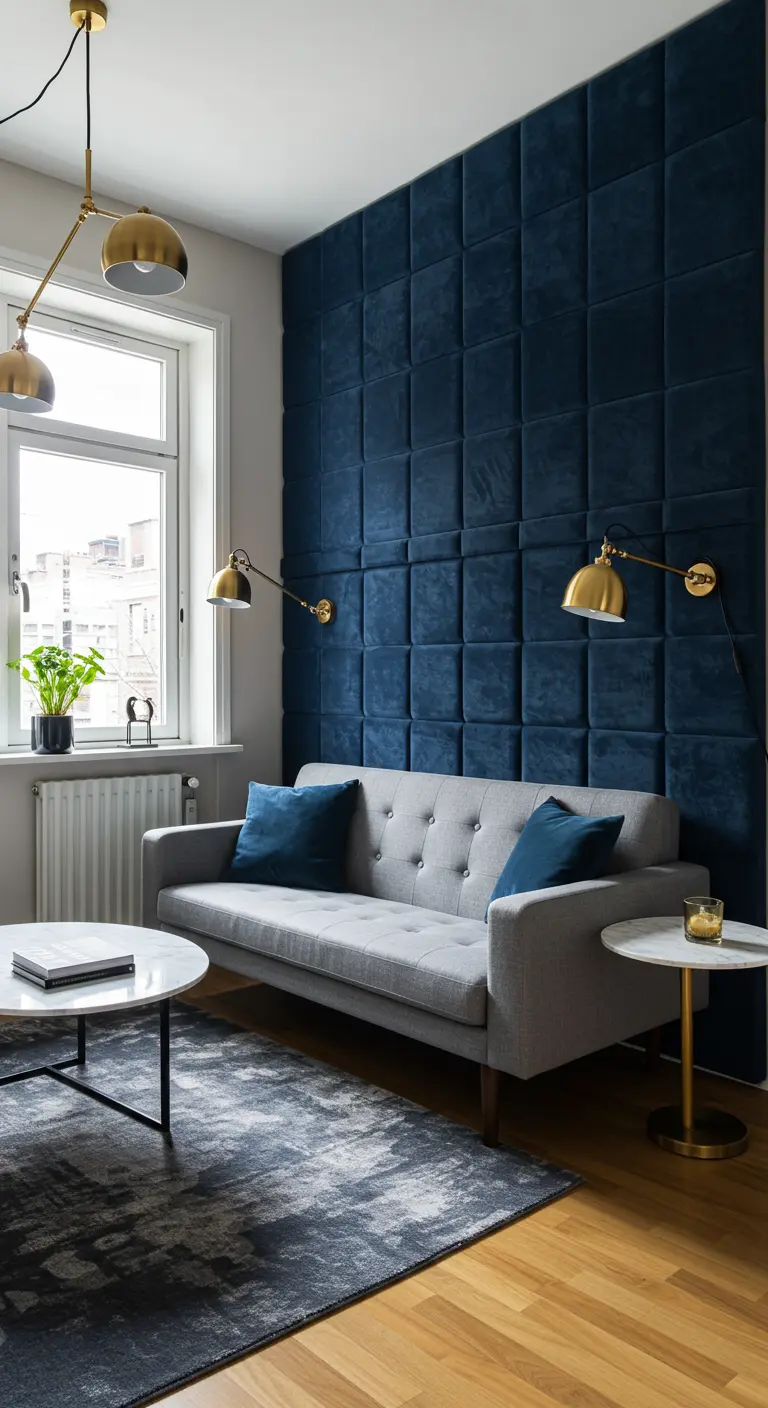
Introduce both luxe texture and sound-dampening qualities to your living room with upholstered wall panels.
A deep velvet, like this navy blue, creates a dramatic, enveloping backdrop for a neutral sofa and adds a layer of quiet sophistication.
This is a brilliant way to add color and depth without the commitment of paint, especially if you’re aiming for moody interiors with a cozy feel.
The grid pattern adds a tailored, geometric structure that contrasts beautifully with soft furnishings and warm brass lighting.
4. Carve Out a Dining Nook with a Curved Screen
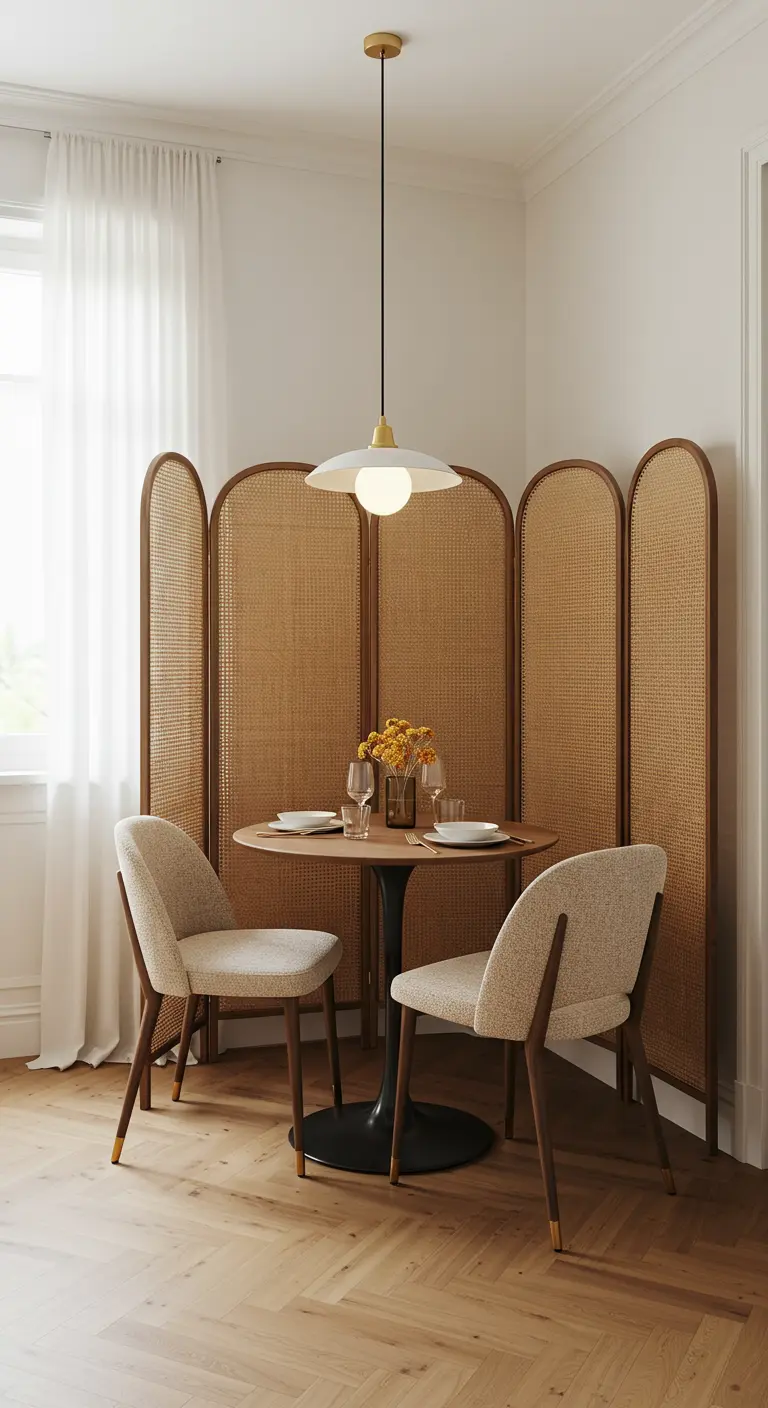
Define an intimate dining area within a larger room by strategically placing a folding screen.
Positioning it in a curve creates a visual embrace, making a simple table for two feel like a private, intentional destination.
The cane screen adds a layer of natural, airy texture that complements the wood flooring and chairs, preventing the corner from feeling boxed in.
This is an effortlessly elegant solution for creating small dining corners in open-concept homes.
5. Lengthen Your Entryway with Horizontal Lines
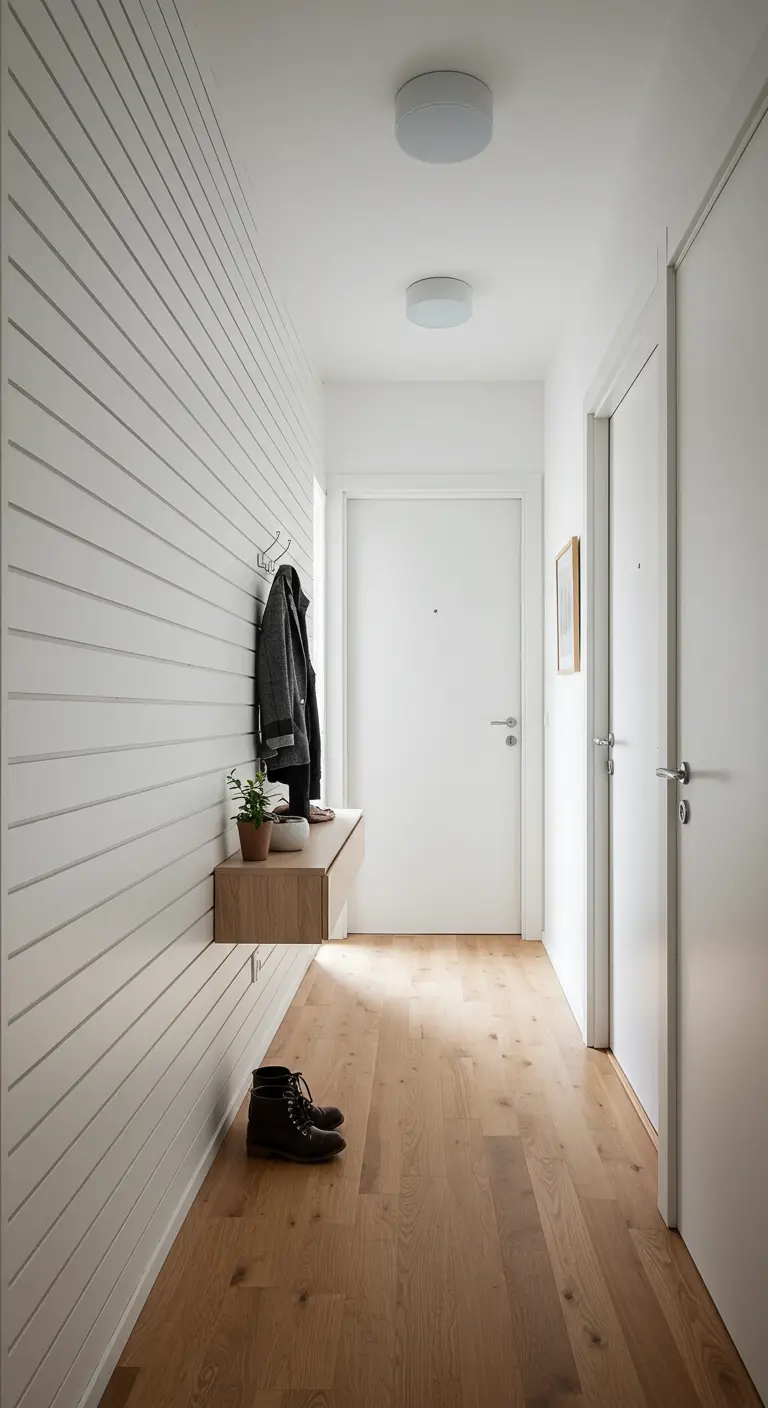
In a narrow hallway, use horizontal paneling or shiplap to create the illusion of a wider, more expansive space.
The clean, repeating lines draw the eye forward, making the journey from the door feel directed and calm.
Painting the paneling a crisp white maximizes light and enhances the uncluttered feel.
A floating wood console with integrated hooks provides essential function without consuming floor space—a key strategy for any tiny entryway.
6. The Soft, Deconstructed Headboard
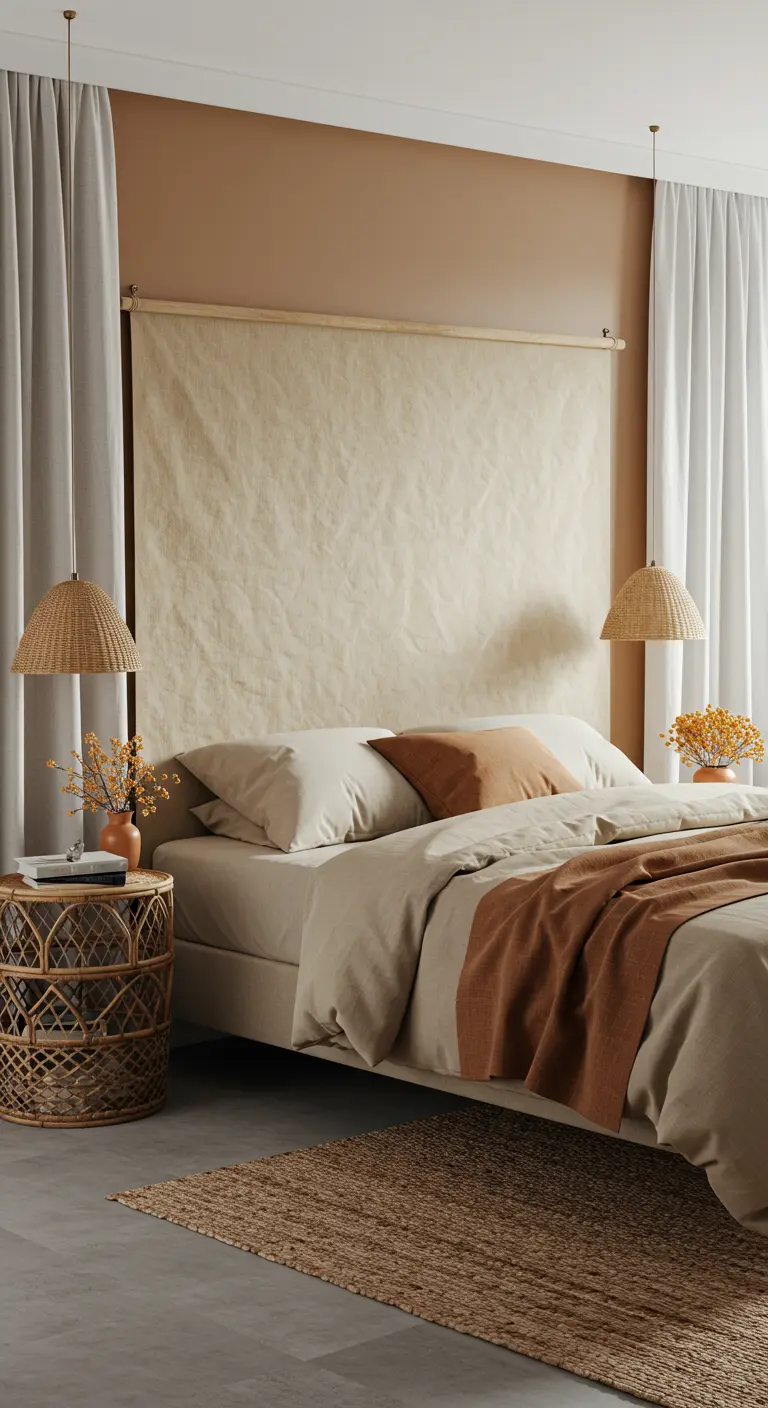
For a relaxed and textural focal point, hang a large piece of raw, unstretched canvas behind your bed.
This serves as a soft, artistic headboard, adding an organic, imperfect feel that is both calming and chic.
Suspend it from a simple wooden dowel to maintain a minimal, grounded look—the natural creases in the fabric are part of its charm.
Pair it with earthy tones and natural materials like rattan and jute for a cohesive, warm earth-tone room.
7. Define a Work Nook with a Slatted Wood Wrap
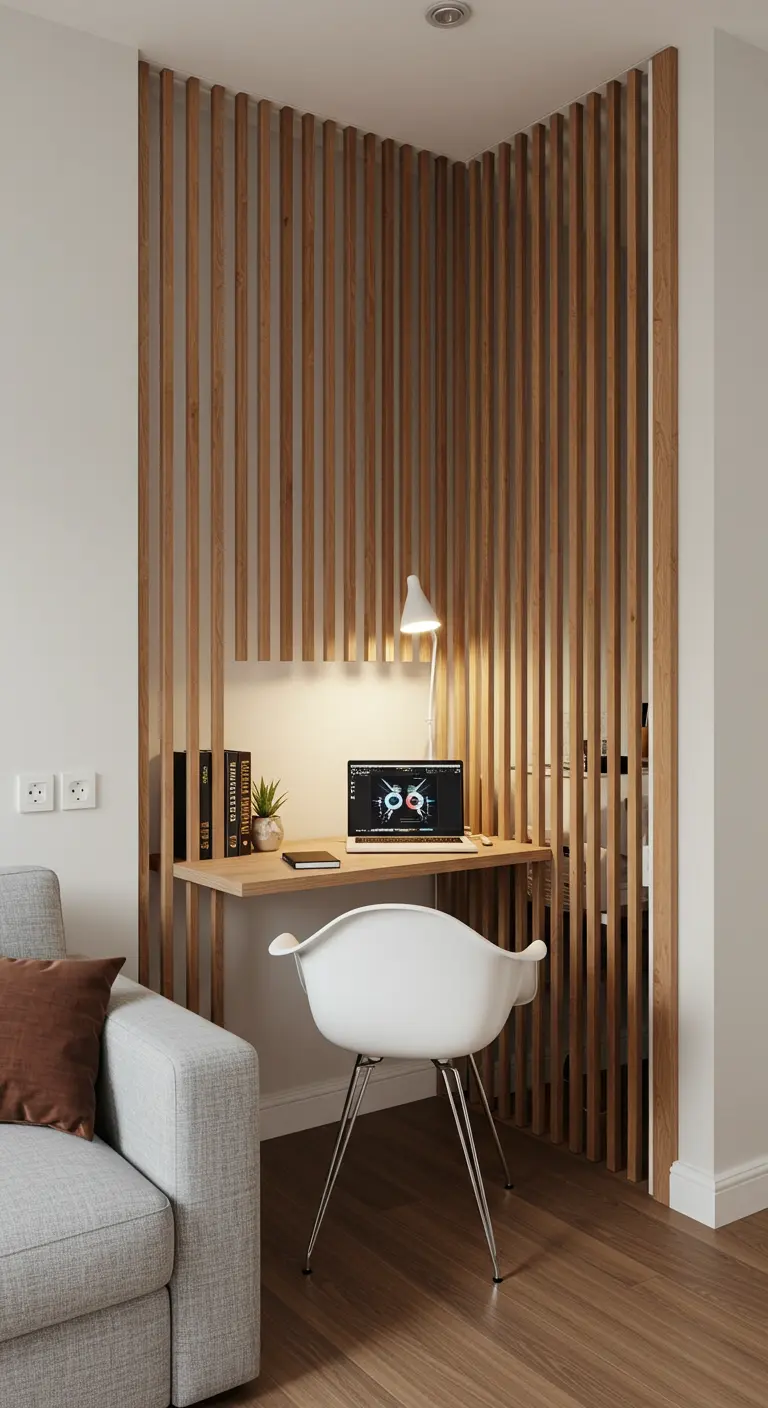
Visually designate a small workspace within a living room by wrapping a corner in vertical wood slats.
This architectural detail creates a distinct zone without building walls, adding warmth, texture, and a sense of purpose to an otherwise unused corner.
A simple floating desk keeps the footprint minimal and ensures the room’s overall flow remains uninterrupted.
This technique is highly effective for carving out functional nooks anywhere in your home.
8. Create a Media Wall with Vertical Slats

Transform your media area into a sophisticated focal point with a floor-to-ceiling wood slat wall.
This treatment adds compelling texture and warmth, cleverly disguising wires while creating a cohesive backdrop for your screen.
Pairing it with a floating console enhances the clean, modern aesthetic and makes the space feel larger.
The natural wood grain prevents the technology from feeling cold, a signature of modern rustic hybrids that blend organic materials with sleek lines.
9. Frame Your Seating with an Arched Screen
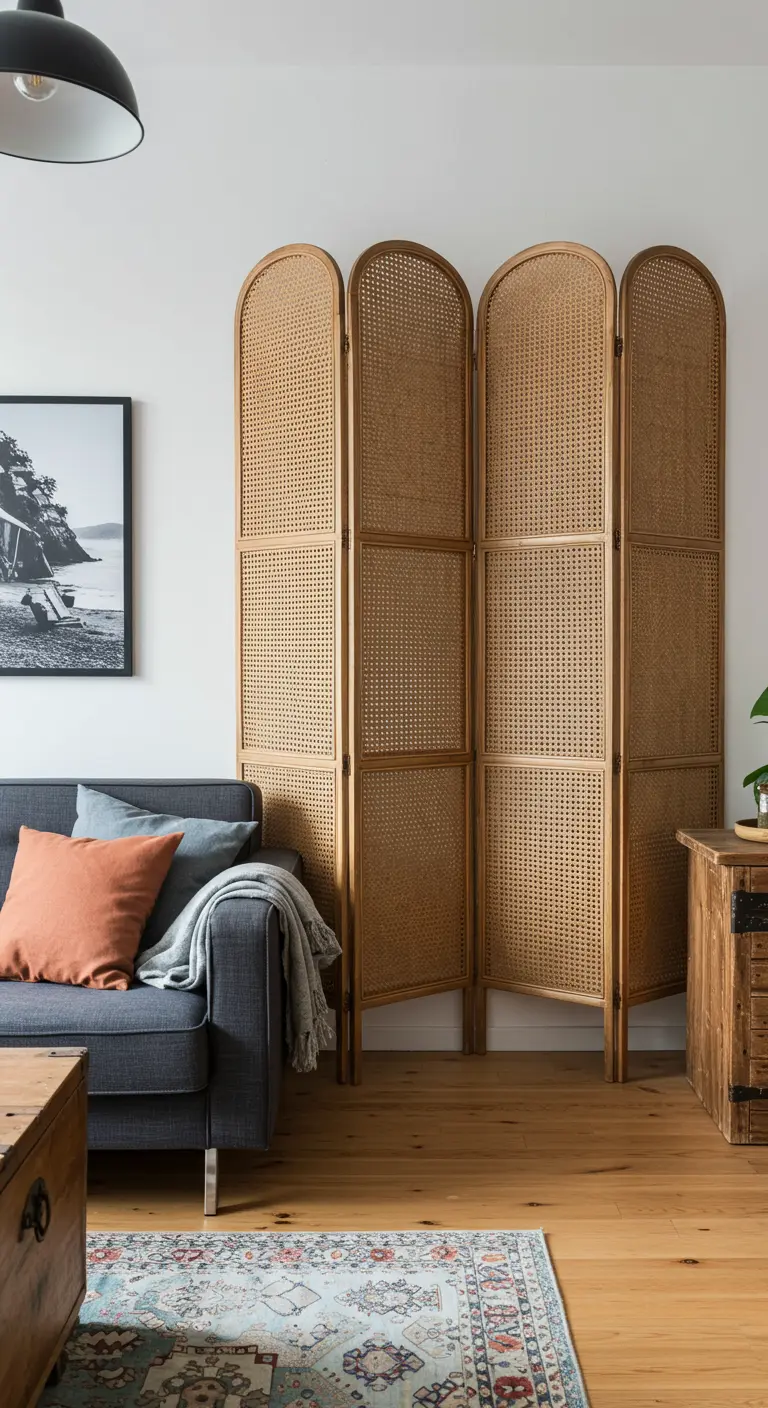
Use a tall, arched folding screen to create an elegant architectural backdrop for your sofa.
This adds height and a soft, curved silhouette to the room, breaking up the straight lines of walls and furniture.
The cane webbing offers texture while remaining visually light, making it a non-permanent way to add interest to a plain wall, particularly in rentals.
This approach adds an element of boho-chic style without overwhelming the room.
10. Envelop a Bed with Fabric-Covered Walls
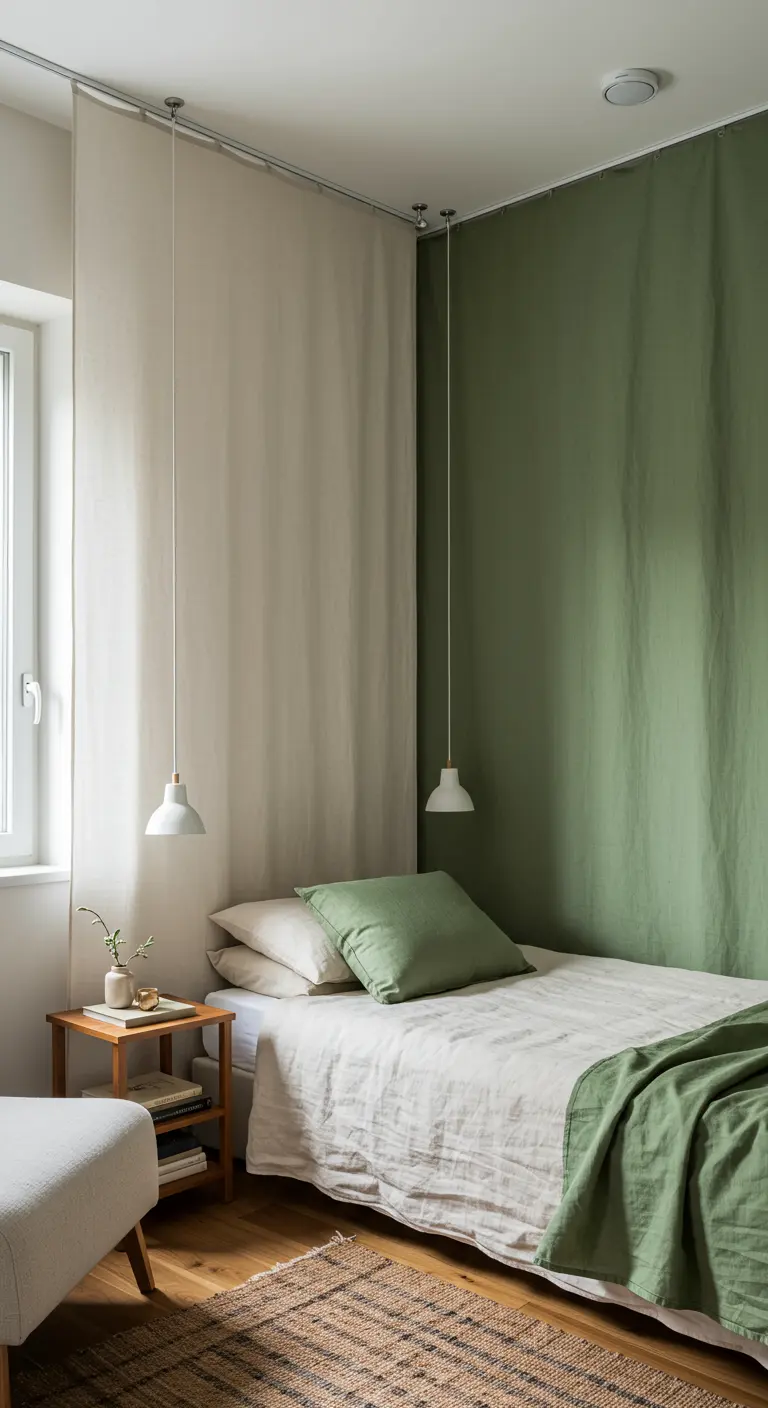
Create a soft, sanctuary-like feel in your bedroom by hanging fabric panels from ceiling-mounted tracks.
This technique defines the sleeping area, adds immense textural warmth, and helps with sound absorption for a quieter, more restful environment.
Choose two complementary colors, like this olive green and cream, to build gentle contrast.
It’s a renter-friendly alternative to paint that makes a space feel incredibly personal and is perfect for soft, romantic bedroom layouts.
11. The High-Contrast Structural Screen
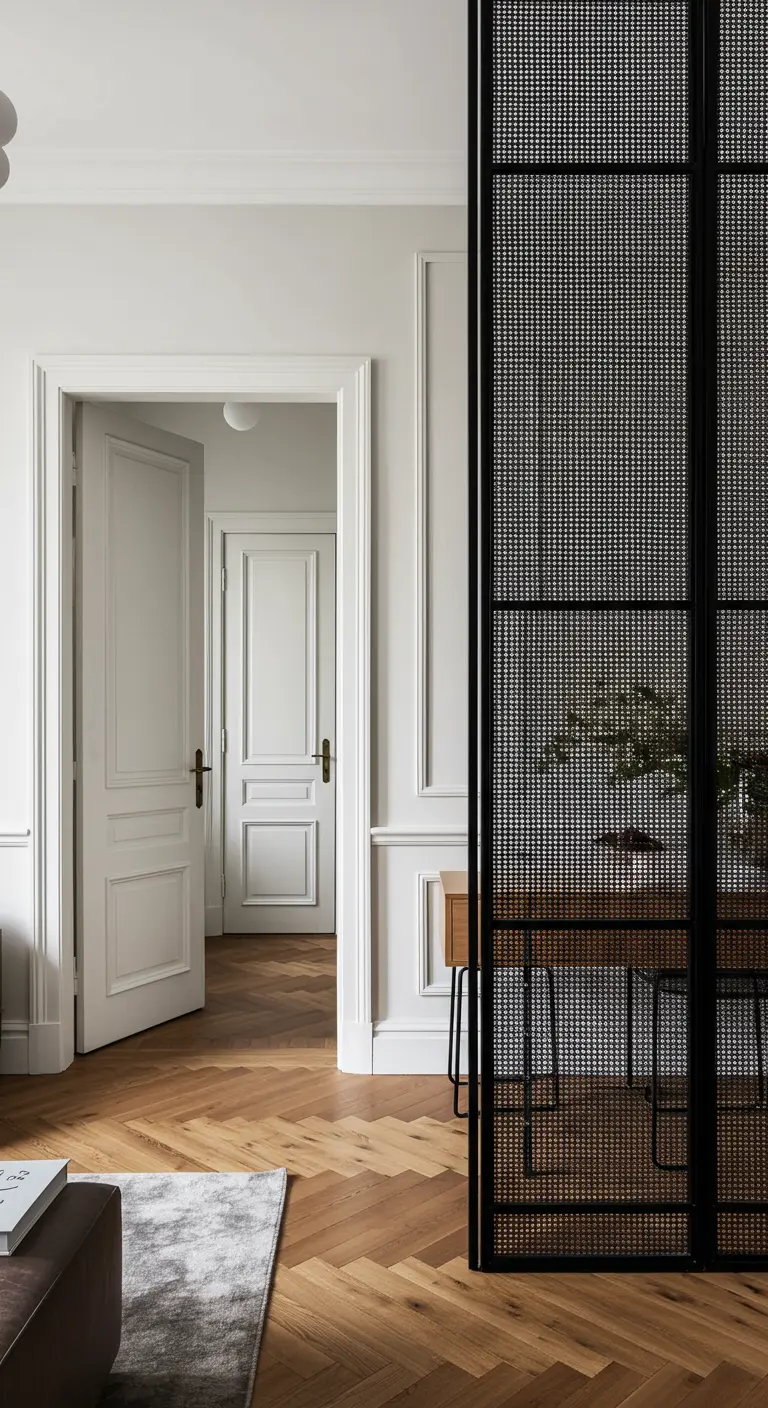
Introduce a bold, graphic element with a cane screen that features a strong, black metal frame.
This modern interpretation of a classic piece provides functional separation while acting as a striking design object in its own right.
The sharp contrast between the dark frame and the natural cane adds a sophisticated, contemporary edge.
Use it to partition an entryway from a living space, adding gravitas to elegant monochrome living rooms.
12. The Focused Workspace with Acoustic Paneling
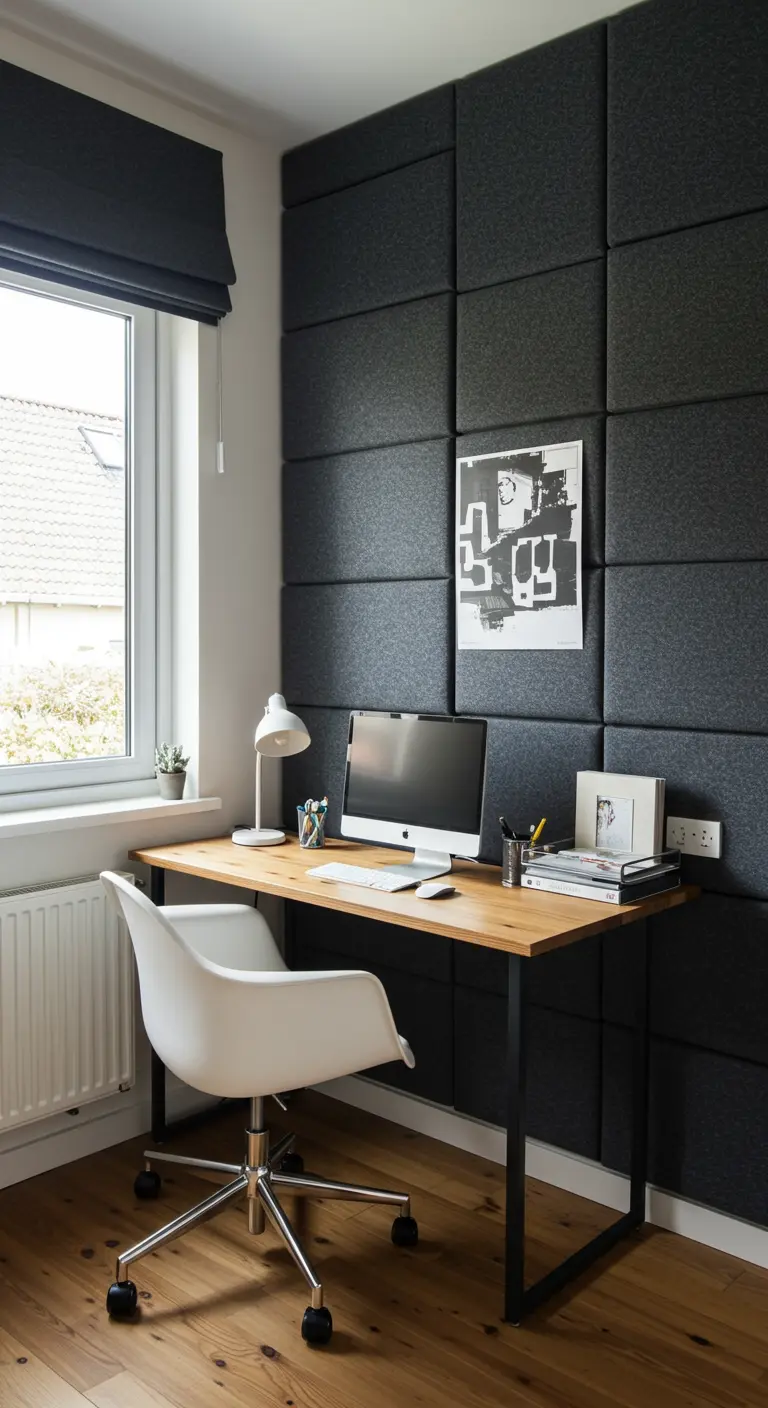
In a home office, sound-absorbing upholstered panels are a fusion of function and high style.
They reduce echo and ambient noise to improve focus, while adding a sophisticated, textural wall finish.
A dark charcoal felt creates a moody, cocooning atmosphere that minimizes visual distraction.
It’s a professional-level upgrade for any work-from-home setup, especially effective in creating moody small spaces designed for concentration.
13. The Layered-Texture Headboard Wall
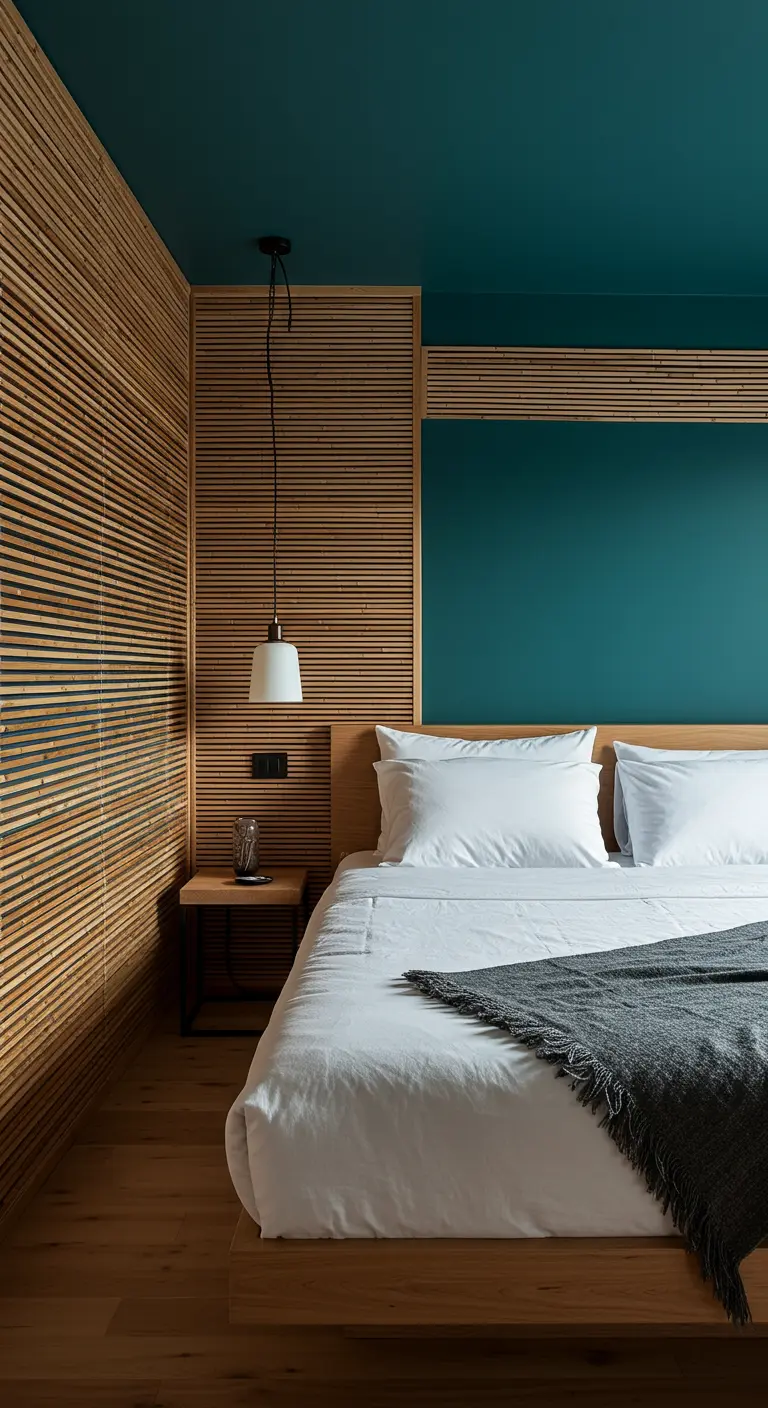
Combine different materials for a rich, layered effect behind the bed.
Here, thin horizontal wood slats are paired with a deeply colored painted section to create a dynamic, custom headboard feature.
The natural wood adds organic warmth, while the deep teal provides a block of calming color that anchors the room.
The simple pendant light adds just a touch of contemporary industrial flair to the composition.
14. The Flexible Zone Divider
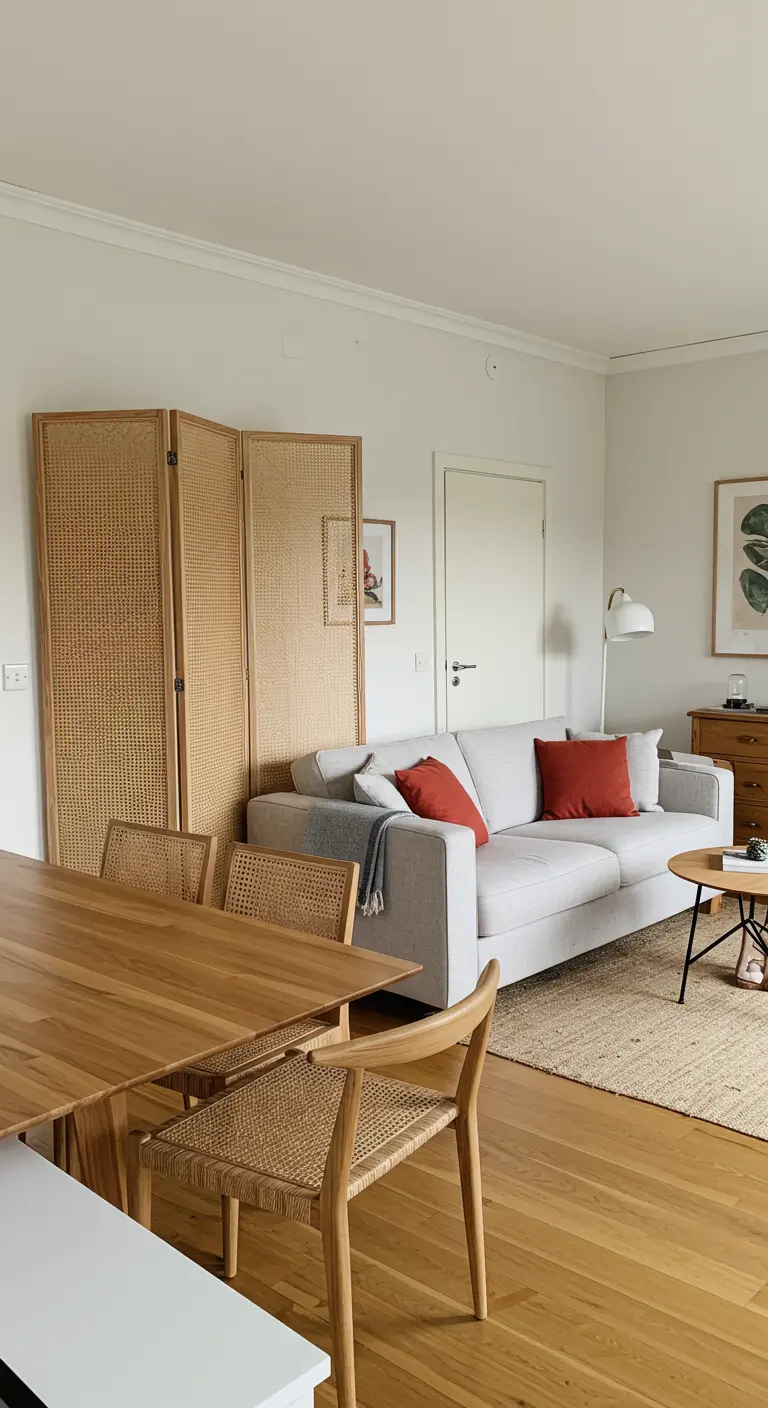
Use a simple, freestanding cane screen to suggest a zone change in an open-concept living and dining area.
Unlike a permanent wall, a screen is flexible; you can move or fold it away completely when you need the extra space.
It provides just enough visual separation to make the dining area feel more intentional without shrinking your home’s footprint.
Its natural texture and simple form align perfectly with the Japandi ethos of blending simplicity with organic warmth.
15. Playful Protection with Soft Wall Panels
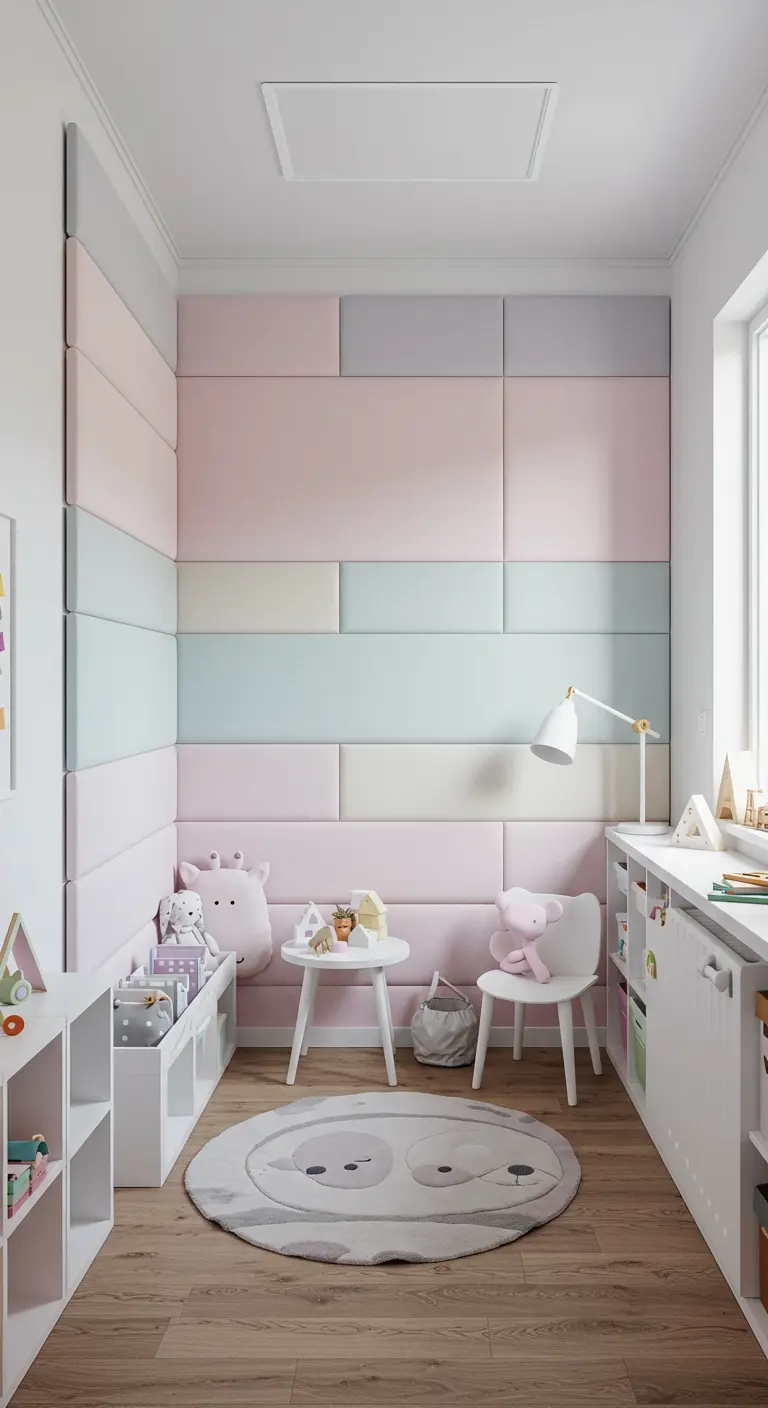
In a child’s room, upholstered wall panels offer a brilliant combination of safety, sound absorption, and style.
The soft surface provides a built-in cushion for active play, while the fabric helps mute noise.
A color-blocked arrangement in soft pastels creates a gentle, cheerful atmosphere without being overstimulating.
This treatment turns a simple corner into a cozy nook, perfect for a dreamy pastel haven.
16. The Moody and Minimalist Slat Wall
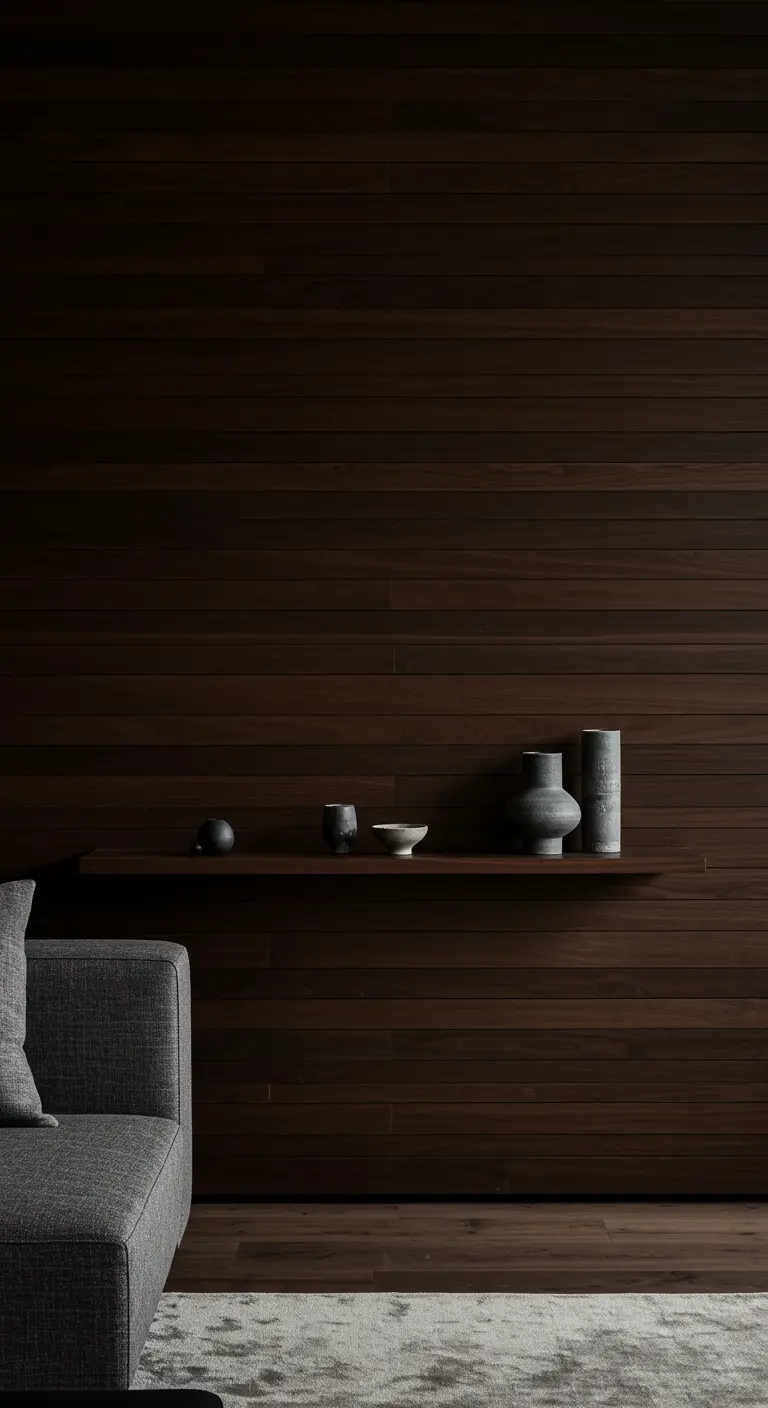
For a dramatic and sophisticated statement, install a wall of dark-stained horizontal wood slats.
The deep color and clean lines create a powerful backdrop that feels both modern and grounding.
A matching floating shelf seems to emerge directly from the wall, offering a seamless surface for displaying curated ceramics or books.
This dark, textural approach proves a space can feel more intimate and enveloping, not smaller.
17. The Ultimate Bohemian Texture Layer
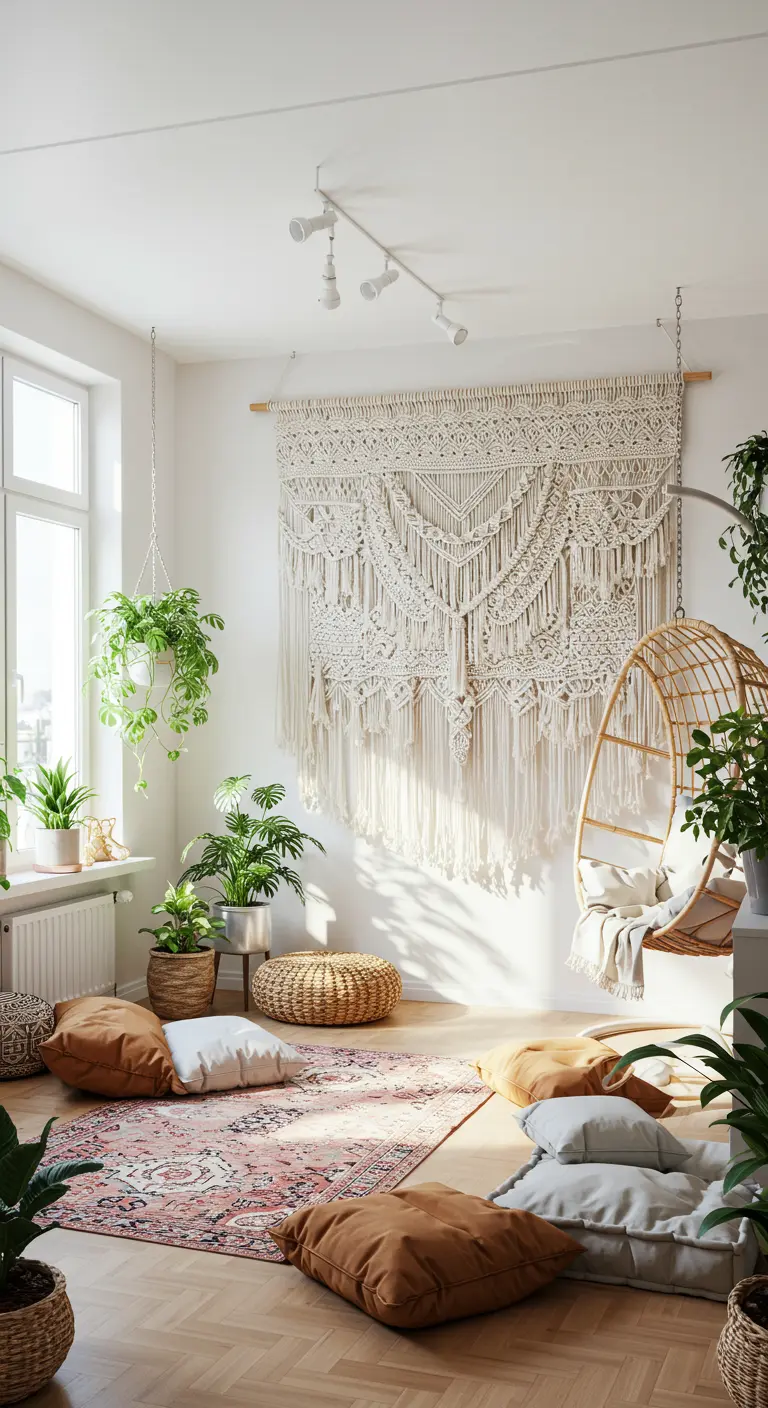
To add significant texture and a powerful focal point, a large-scale macrame wall hanging is an unparalleled choice.
It instantly introduces a handmade, artisanal quality that gives a room soul.
The intricate knots and soft fringe provide a wealth of tactile and visual interest that animates a simple white wall.
This is a foundational piece for any Scandinavian-boho fusion space, creating an inviting lounge zone wherever it’s placed.
18. Woven Texture as Framed Art
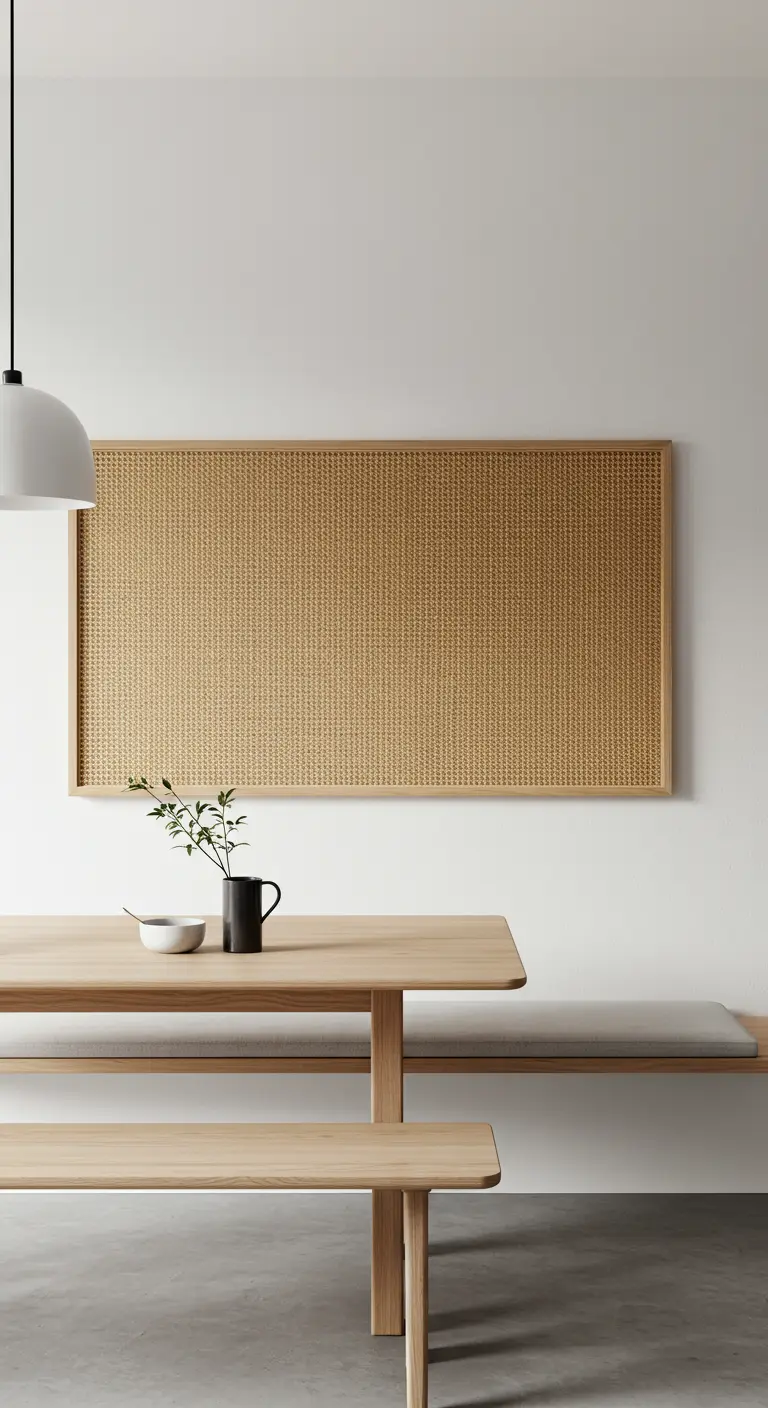
If an entire screen feels like too much for your space, mount a single framed panel of cane webbing on the wall.
Treated as a piece of minimalist art, it adds a dose of organic texture and a refined, sculptural quality.
This is an excellent way to bring the warmth of natural materials into a clean, contemporary room without adding clutter.
It’s a subtle nod to the contemporary Zen aesthetic, perfect above a bench or console.
19. The Architecturally Defined Reading Corner

Transform an unused corner into an inviting destination by cladding the walls in vertical wood slats.
This treatment not only adds warmth and texture but makes the nook feel intentional and enveloping—the ideal setting for a comfortable armchair.
The vertical lines draw the eye upward, giving the small corner a sense of height and architectural importance.
It’s a sophisticated way to create cozy corners that feel truly integrated into your home’s design.
20. The Dramatic Channel-Tufted Headboard
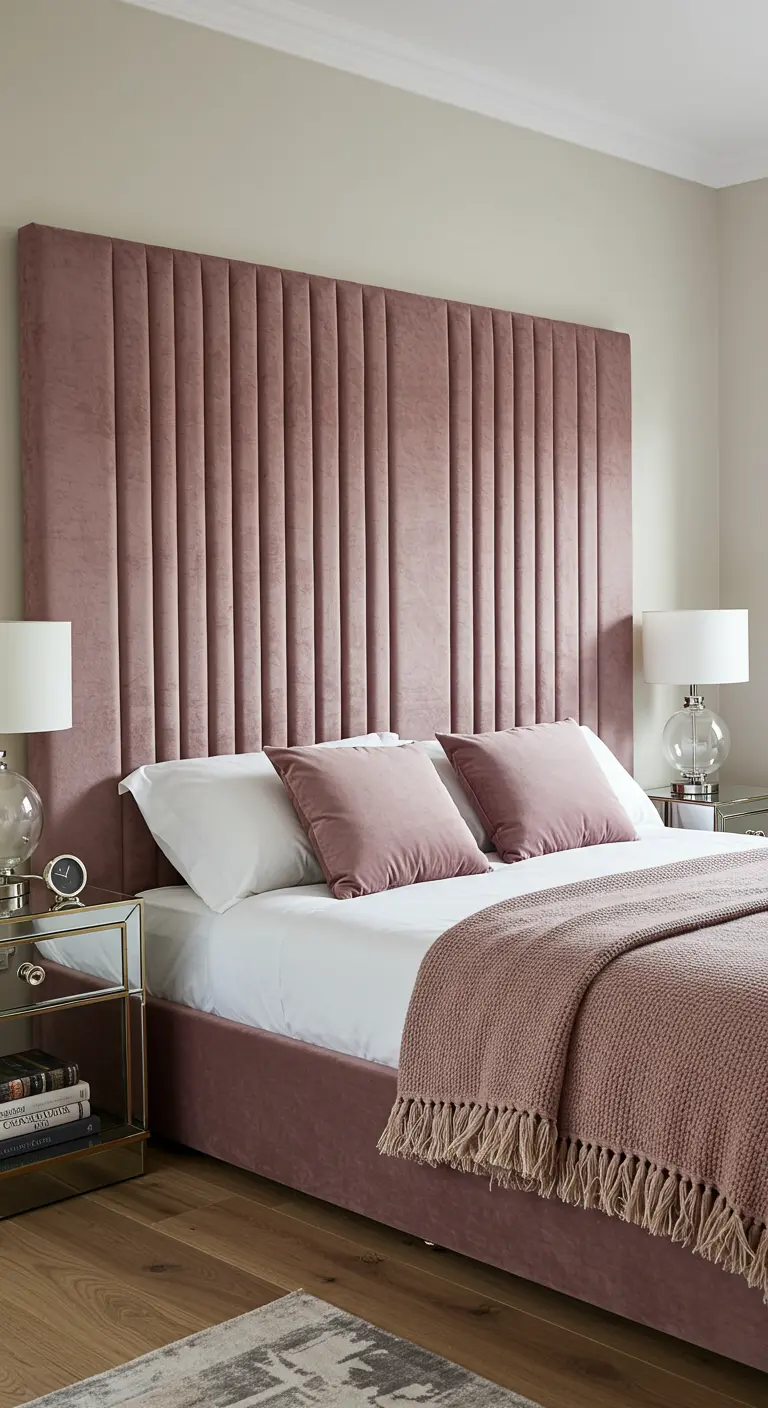
Make a truly luxurious statement with an extra-tall, channel-tufted headboard.
The strong vertical lines create a sense of grandeur and height, while the plush velvet adds undeniable softness and glamour.
A headboard of this scale acts as an accent wall in itself, providing a rich textural backdrop for your bed and pillows.
In a dusty rose, it becomes the centerpiece of ultra-feminine blush pink bedroom retreats, especially when paired with mirrored nightstands.
21. The Breezy Balcony Privacy Screen
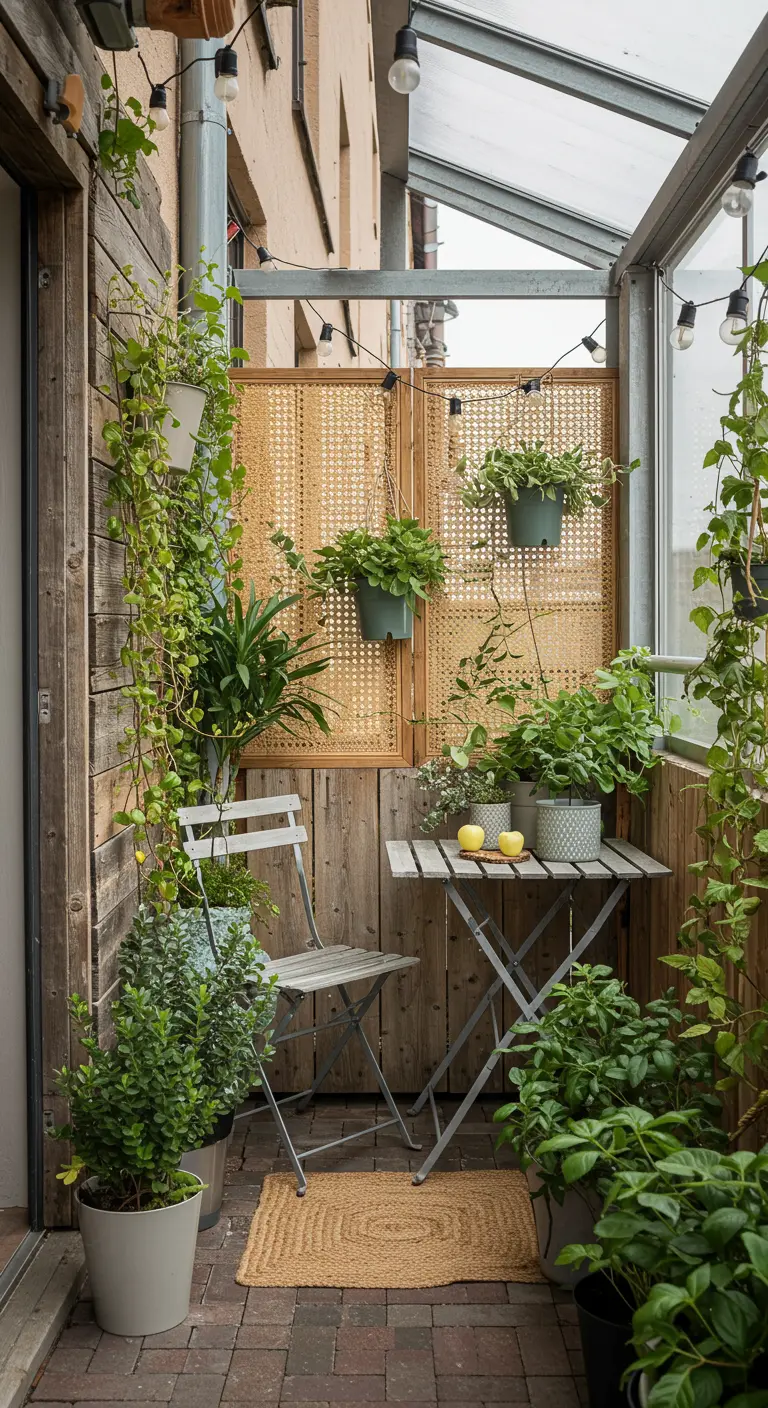
Use simple cane panels to add privacy and texture to a balcony or patio.
Hung from an overhead structure, they filter harsh sunlight and create a sense of enclosure without blocking essential airflow.
This is an ideal, non-permanent solution for city dwellers who want to create a small, private oasis.
The natural material works beautifully with greenery and rustic wood, a key feature in stylish boho-minimalist balconies.
22. The Fluted Kitchen Island
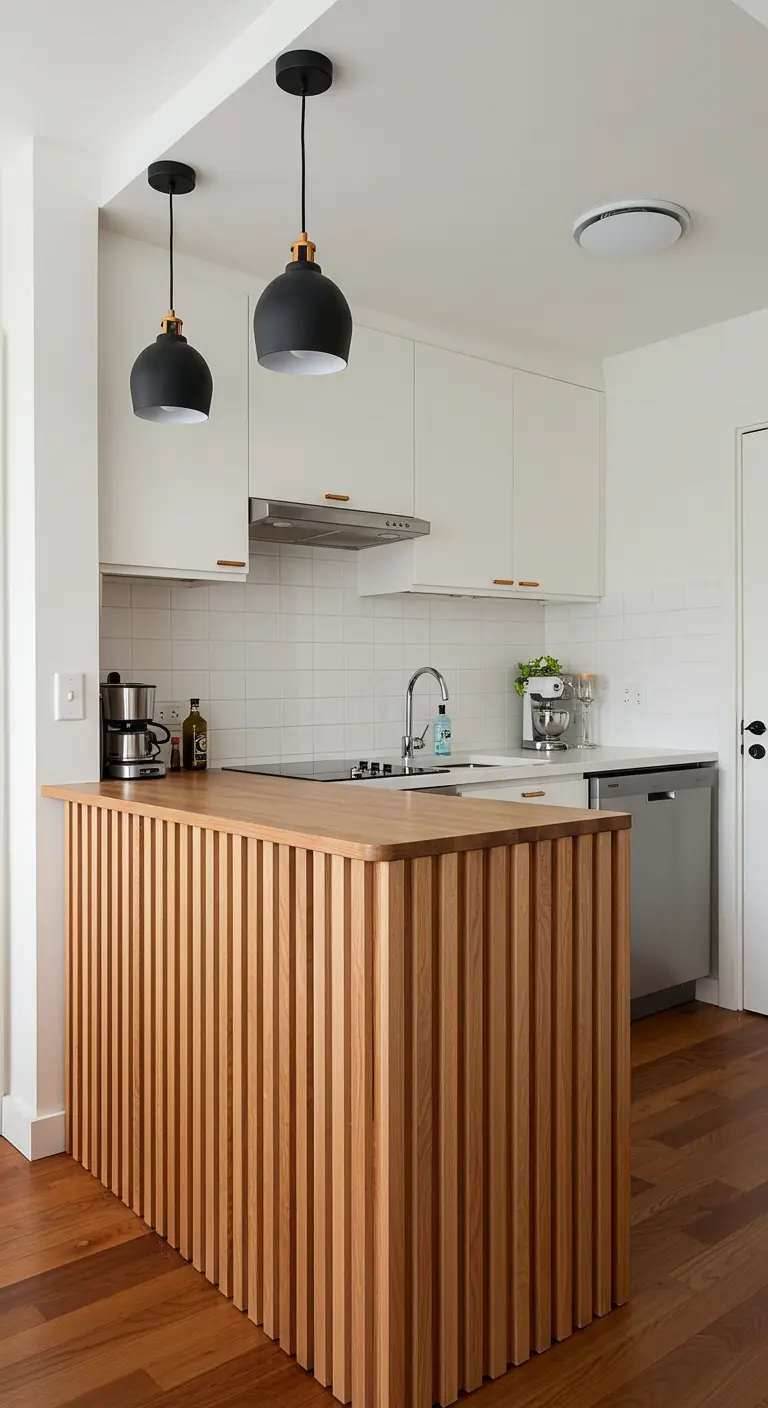
Add immediate architectural interest to a standard kitchen by cladding the island in vertical wood slats.
This “fluted” or “tambour” effect introduces sophisticated texture and a custom, high-end feel.
It’s a beautiful way to break up the flat, sterile planes of a typical kitchen, adding a layer of warm, natural material.
The detail is especially effective in open-plan spaces, complementing the clean lines of minimalist all-white kitchens.
23. The Cocooning Bouclé Nook
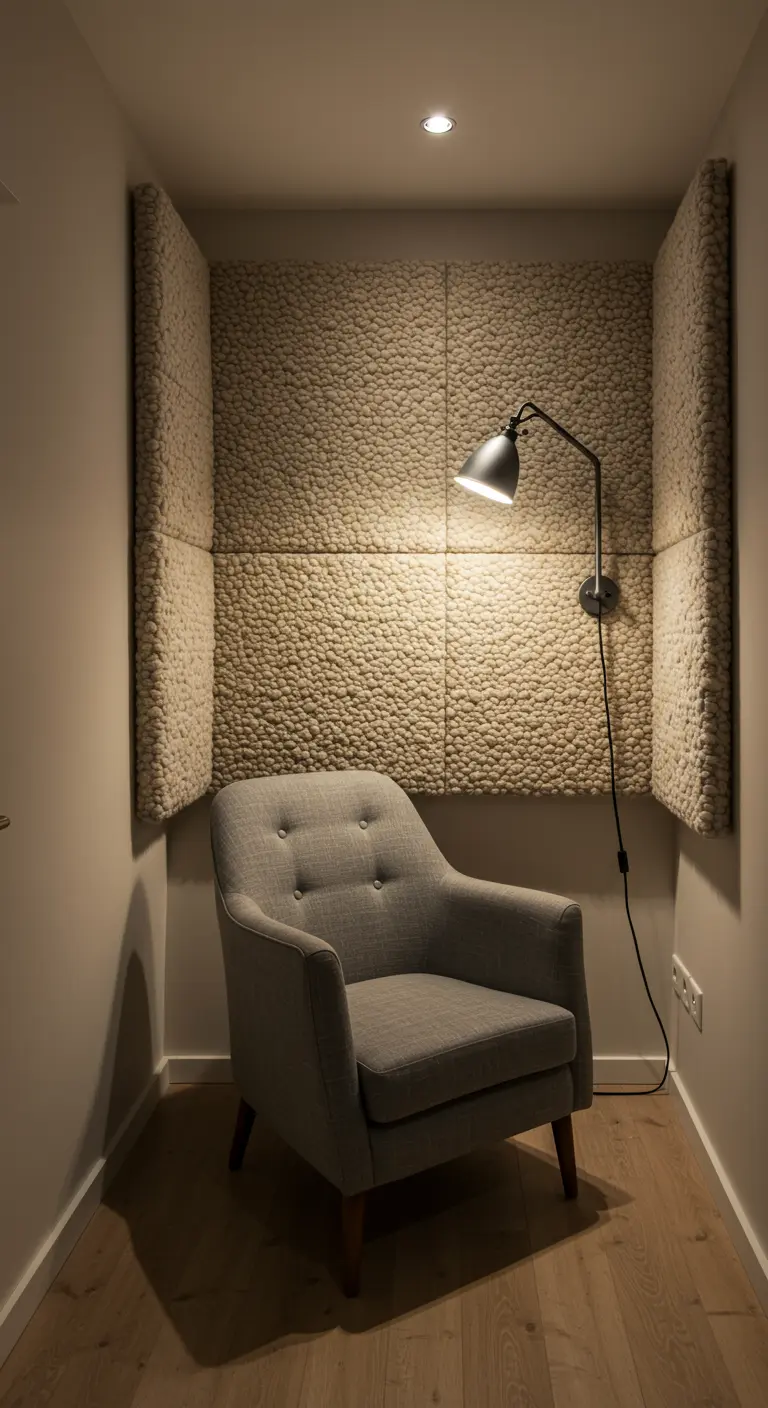
Line a small nook with bouclé-covered panels for the ultimate cozy retreat.
The nubby, looped texture is incredibly inviting and has excellent acoustic properties, making it perfect for a quiet reading corner or phone booth.
A warm, neutral tone keeps the small space feeling serene, not claustrophobic.
By wrapping the walls, you create an immersive, soft-touch experience, transforming a simple alcove into a serene, spa-like space.
24. The Integrated Wall-and-Screen Divider
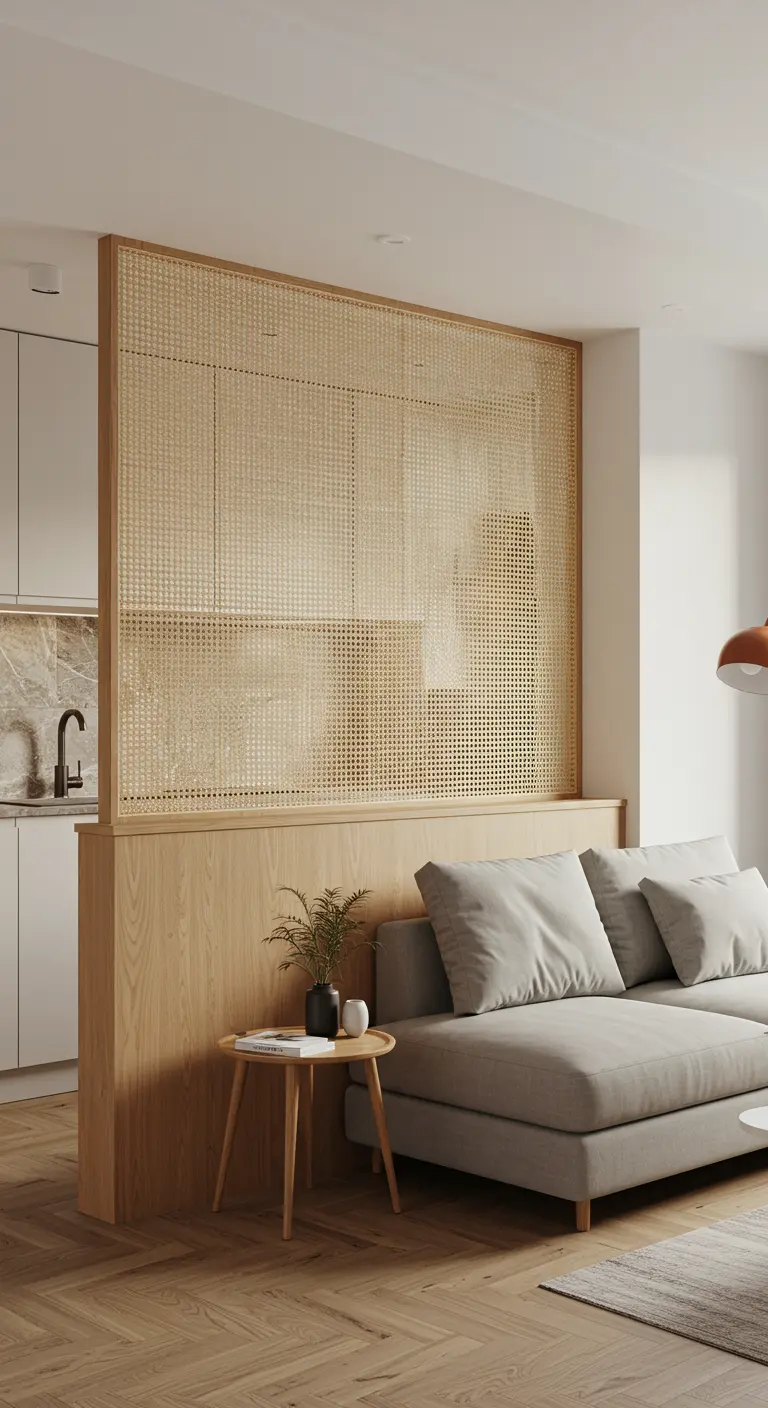
Combine solid structure with visual lightness by topping a half-wall with a framed cane panel.
This custom solution clearly delineates a space—like separating a kitchen from a living area—while still allowing light and conversation to flow freely.
The solid base can house electrical outlets or anchor a sofa, while the woven top maintains an airy feel.
It’s a sophisticated, built-in look for small spaces that need open sight lines.
25. The Modern Vertical Shiplap Wall
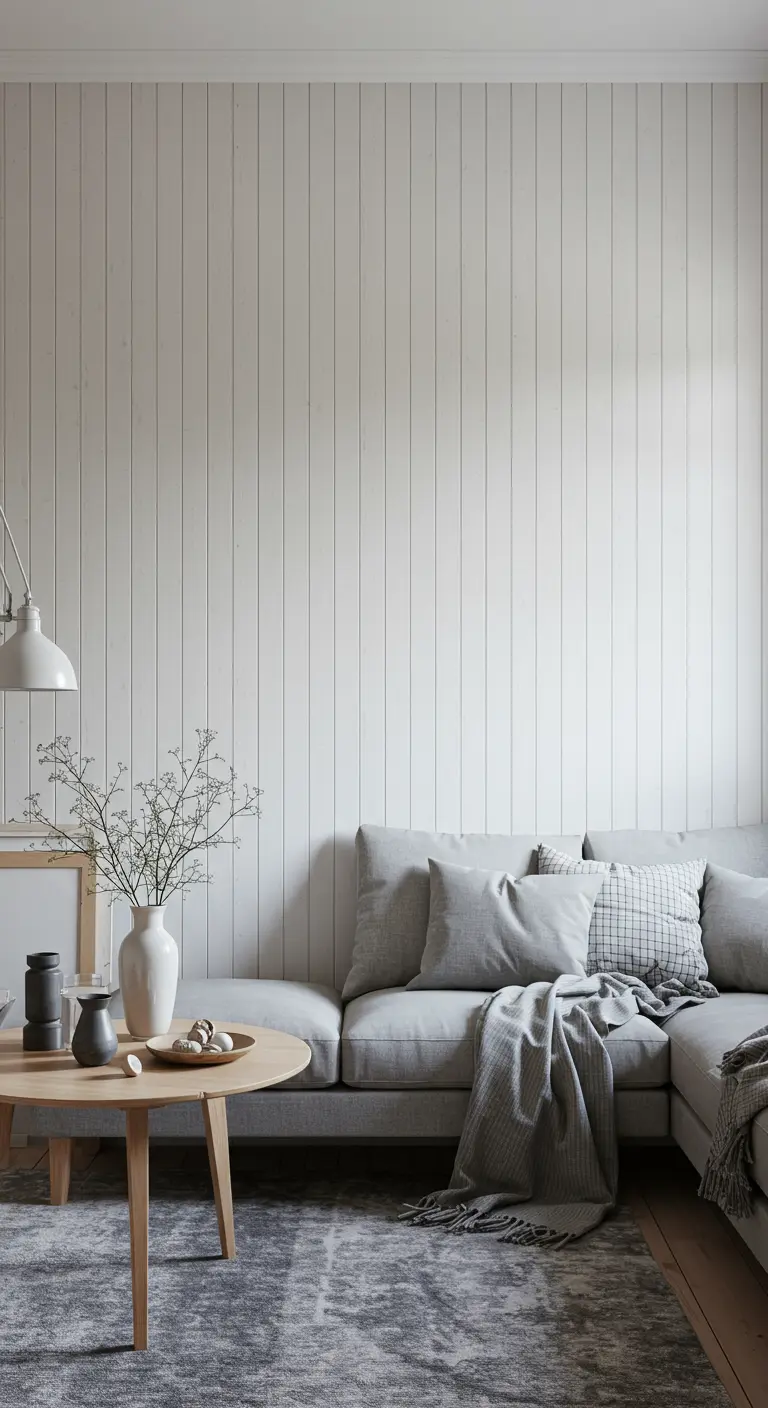
Reimagine shiplap with a clean, vertical application for a modern and serene living room wall.
Painted a soft white, the vertical lines draw the eye upward, subtly making the ceiling feel higher and the room more spacious.
This understated texture adds depth and character without overwhelming the space, providing a perfect neutral backdrop for soft, comfortable furniture.
This look is a cornerstone of Scandinavian hygge design, which champions light and texture.
26. The Soft Closet Door Solution
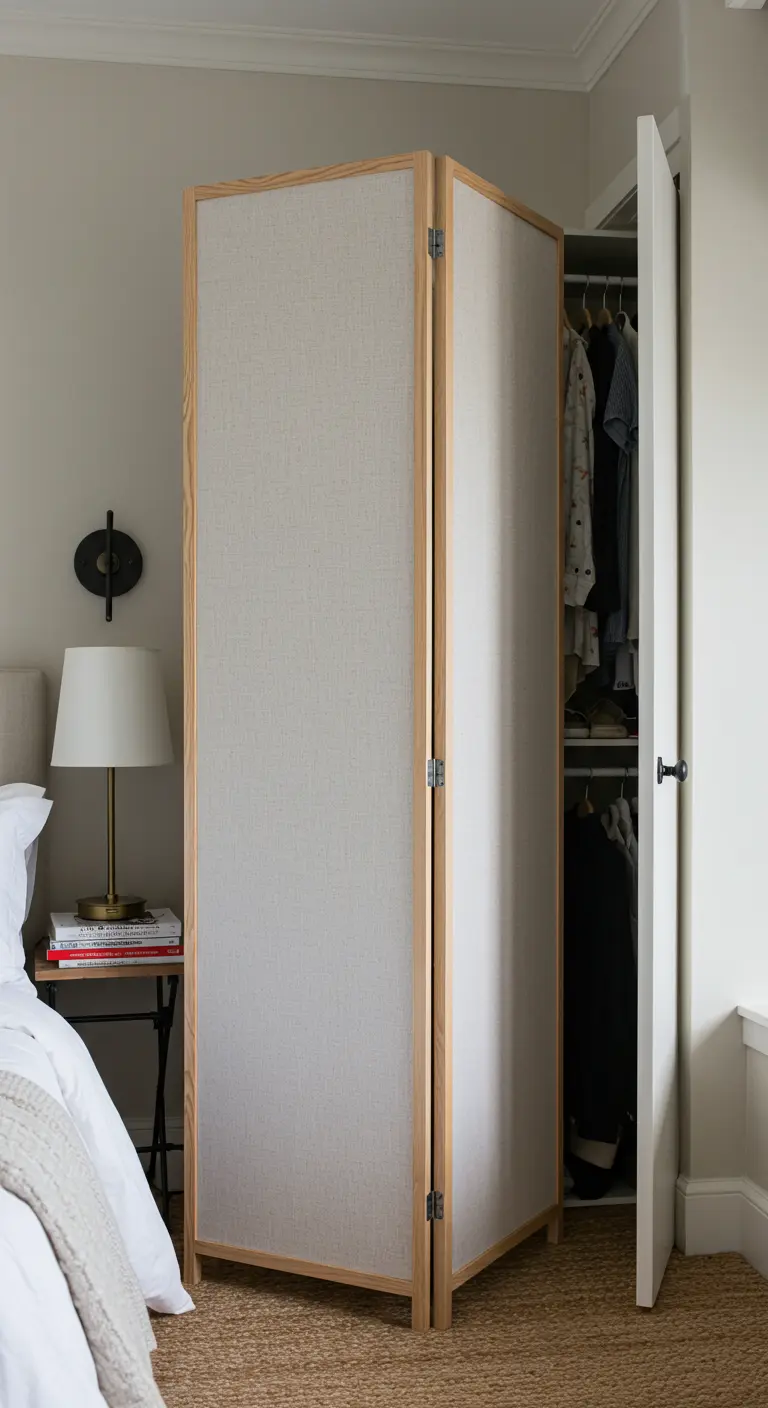
Conceal an open closet or a cluttered storage area with a simple, fabric-covered folding screen.
A light-colored linen or canvas panel offers a softer, more textural alternative to a traditional door and requires no installation.
This makes it a perfect solution for rentals or for spaces where a swinging door would be awkward or interrupt flow.
The natural wood frame and neutral fabric integrate seamlessly into a calm, neutral-toned bedroom.
27. The Color-Blocked Acoustic Nook
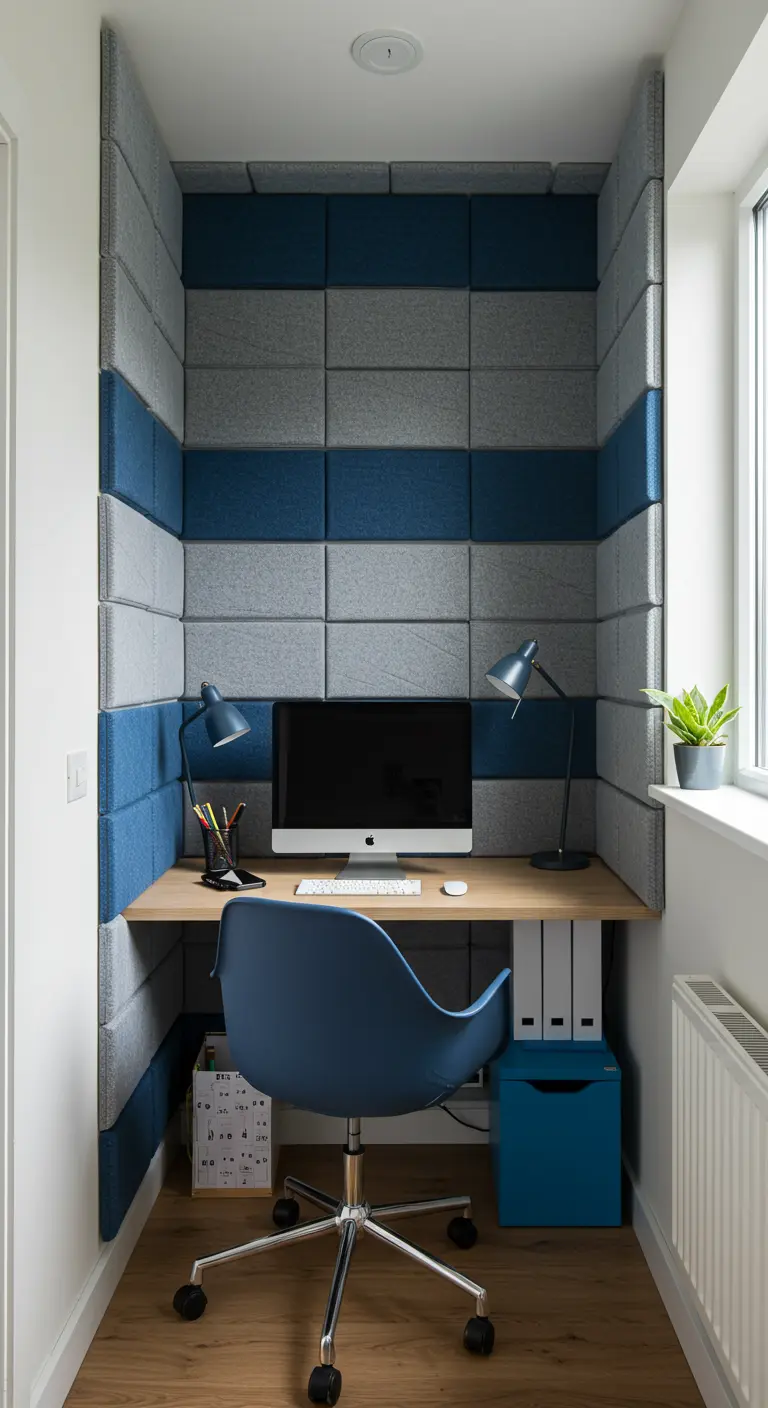
Bring dynamic energy and high function to a compact workspace with color-blocked upholstered panels.
This treatment adds bold visual interest, helps absorb sound for better focus, and defines the nook as a dedicated work zone.
Using alternating colors like blue and gray creates a graphic pattern that can make a small alcove feel like a thoughtful design feature.
It’s a smart way to maximize function in elevated studio apartments and other small homes.
28. Layering Warmth with Earth Tones
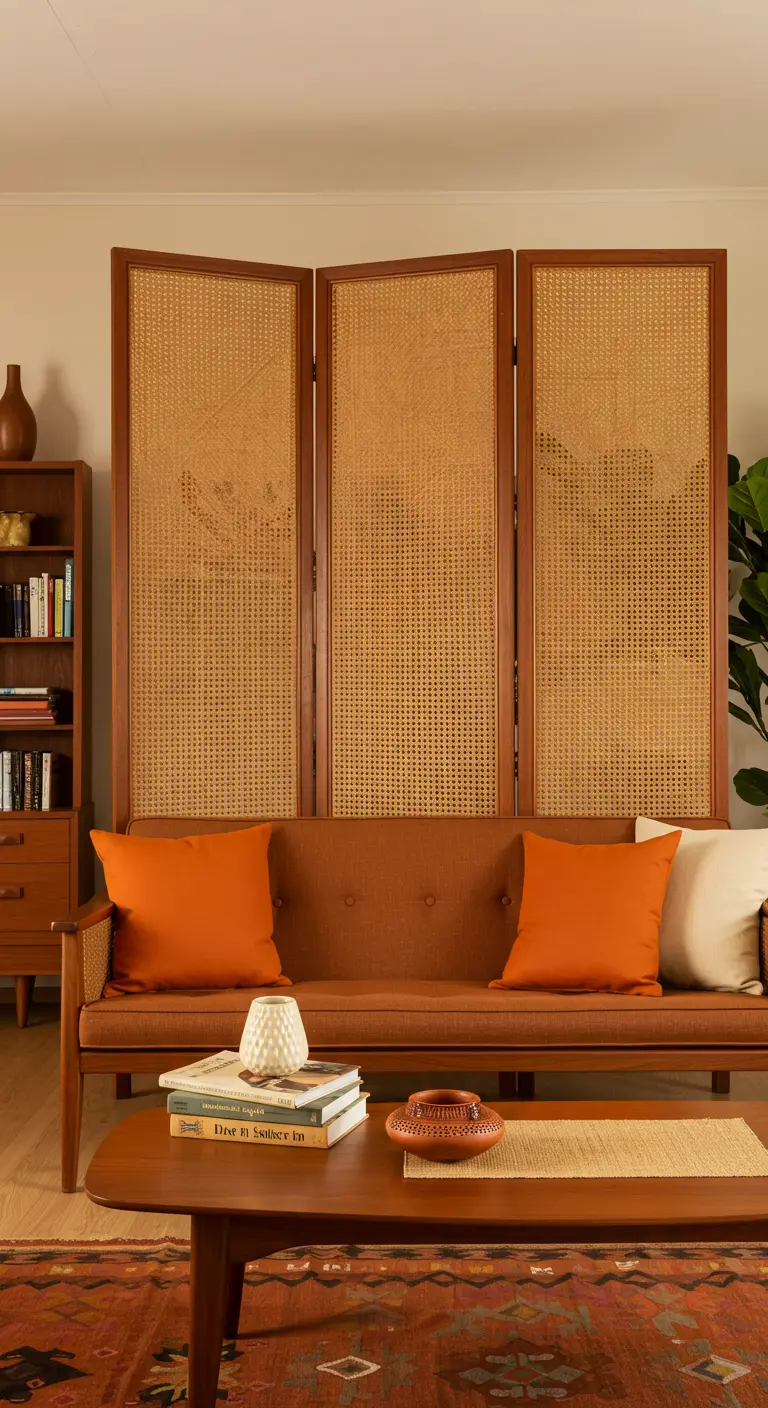
Create a deeply warm and inviting atmosphere by layering similar earth tones that have different textures.
Here, a natural cane screen provides a woven, airy backdrop for a rich, rust-colored sofa upholstered in a soft fabric.
The combination feels cohesive and intentional, drawing you into the space with its enveloping warmth.
This thoughtful layering technique is central to creating sophisticated and comfortable desert-inspired interiors.
